Skeletal Metastases of Neuroblastoma: A Systematic Review of Imaging Techniques
VerifiedAdded on 2022/11/15
|23
|9507
|453
AI Summary
This study provides a detailed description of neuroblastoma, a cancer that develops from undeveloped nerve cells. It also includes strategies to detect the presence of tumours using PET scan and bone scintigraphy. The report analyses data from journal articles and explains the statistics about the detection of cancer. The review evaluates the most recent papers that have used PET scan with NaF and FDG tracers and Tc-99m MDP bone scan, which will evaluate the skeletal metastases of neuroblastoma using a systematic review of the literature and data meta-analysis.
Contribute Materials
Your contribution can guide someone’s learning journey. Share your
documents today.
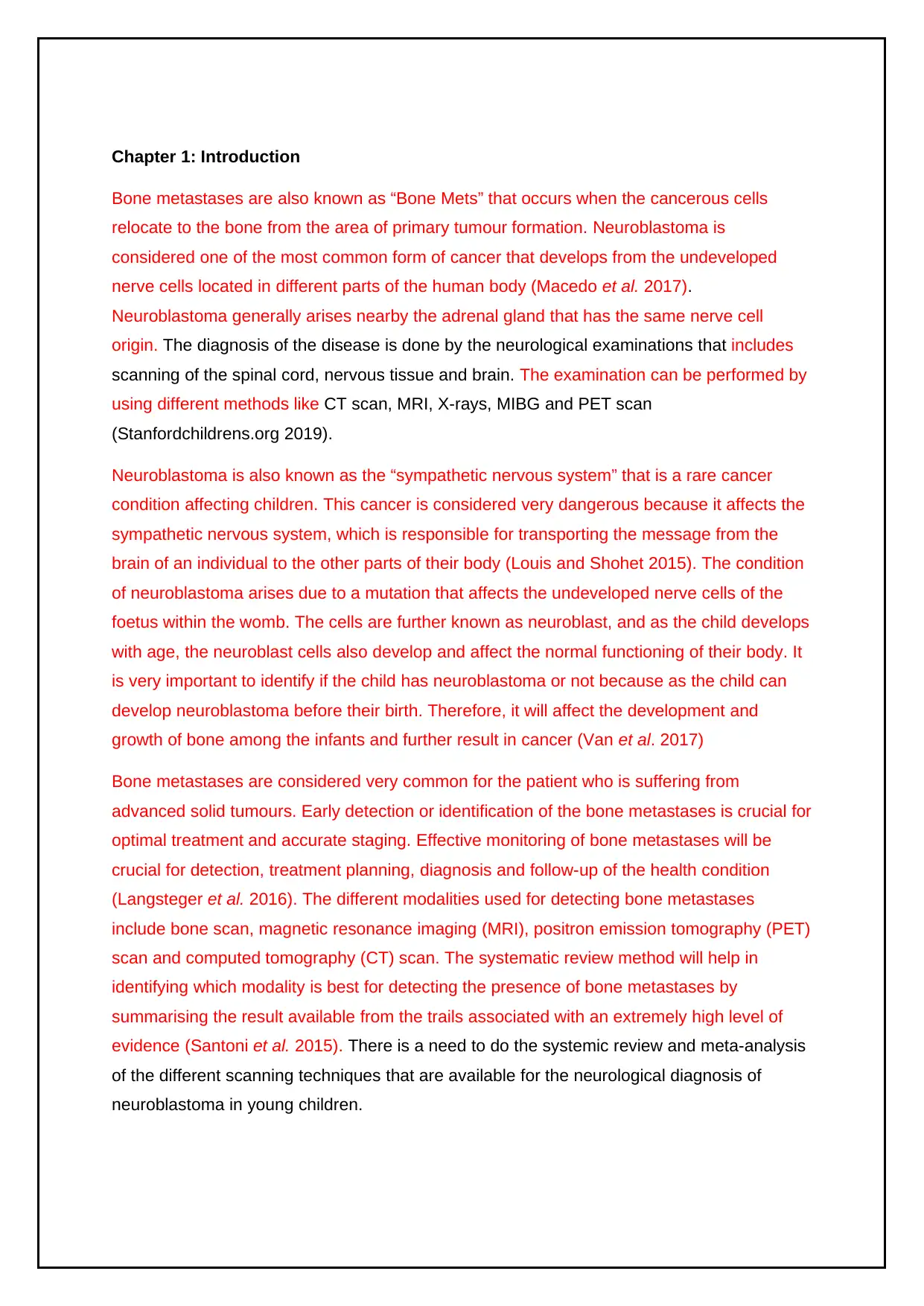
Chapter 1: Introduction
Bone metastases are also known as “Bone Mets” that occurs when the cancerous cells
relocate to the bone from the area of primary tumour formation. Neuroblastoma is
considered one of the most common form of cancer that develops from the undeveloped
nerve cells located in different parts of the human body (Macedo et al. 2017).
Neuroblastoma generally arises nearby the adrenal gland that has the same nerve cell
origin. The diagnosis of the disease is done by the neurological examinations that includes
scanning of the spinal cord, nervous tissue and brain. The examination can be performed by
using different methods like CT scan, MRI, X-rays, MIBG and PET scan
(Stanfordchildrens.org 2019).
Neuroblastoma is also known as the “sympathetic nervous system” that is a rare cancer
condition affecting children. This cancer is considered very dangerous because it affects the
sympathetic nervous system, which is responsible for transporting the message from the
brain of an individual to the other parts of their body (Louis and Shohet 2015). The condition
of neuroblastoma arises due to a mutation that affects the undeveloped nerve cells of the
foetus within the womb. The cells are further known as neuroblast, and as the child develops
with age, the neuroblast cells also develop and affect the normal functioning of their body. It
is very important to identify if the child has neuroblastoma or not because as the child can
develop neuroblastoma before their birth. Therefore, it will affect the development and
growth of bone among the infants and further result in cancer (Van et al. 2017)
Bone metastases are considered very common for the patient who is suffering from
advanced solid tumours. Early detection or identification of the bone metastases is crucial for
optimal treatment and accurate staging. Effective monitoring of bone metastases will be
crucial for detection, treatment planning, diagnosis and follow-up of the health condition
(Langsteger et al. 2016). The different modalities used for detecting bone metastases
include bone scan, magnetic resonance imaging (MRI), positron emission tomography (PET)
scan and computed tomography (CT) scan. The systematic review method will help in
identifying which modality is best for detecting the presence of bone metastases by
summarising the result available from the trails associated with an extremely high level of
evidence (Santoni et al. 2015). There is a need to do the systemic review and meta-analysis
of the different scanning techniques that are available for the neurological diagnosis of
neuroblastoma in young children.
Bone metastases are also known as “Bone Mets” that occurs when the cancerous cells
relocate to the bone from the area of primary tumour formation. Neuroblastoma is
considered one of the most common form of cancer that develops from the undeveloped
nerve cells located in different parts of the human body (Macedo et al. 2017).
Neuroblastoma generally arises nearby the adrenal gland that has the same nerve cell
origin. The diagnosis of the disease is done by the neurological examinations that includes
scanning of the spinal cord, nervous tissue and brain. The examination can be performed by
using different methods like CT scan, MRI, X-rays, MIBG and PET scan
(Stanfordchildrens.org 2019).
Neuroblastoma is also known as the “sympathetic nervous system” that is a rare cancer
condition affecting children. This cancer is considered very dangerous because it affects the
sympathetic nervous system, which is responsible for transporting the message from the
brain of an individual to the other parts of their body (Louis and Shohet 2015). The condition
of neuroblastoma arises due to a mutation that affects the undeveloped nerve cells of the
foetus within the womb. The cells are further known as neuroblast, and as the child develops
with age, the neuroblast cells also develop and affect the normal functioning of their body. It
is very important to identify if the child has neuroblastoma or not because as the child can
develop neuroblastoma before their birth. Therefore, it will affect the development and
growth of bone among the infants and further result in cancer (Van et al. 2017)
Bone metastases are considered very common for the patient who is suffering from
advanced solid tumours. Early detection or identification of the bone metastases is crucial for
optimal treatment and accurate staging. Effective monitoring of bone metastases will be
crucial for detection, treatment planning, diagnosis and follow-up of the health condition
(Langsteger et al. 2016). The different modalities used for detecting bone metastases
include bone scan, magnetic resonance imaging (MRI), positron emission tomography (PET)
scan and computed tomography (CT) scan. The systematic review method will help in
identifying which modality is best for detecting the presence of bone metastases by
summarising the result available from the trails associated with an extremely high level of
evidence (Santoni et al. 2015). There is a need to do the systemic review and meta-analysis
of the different scanning techniques that are available for the neurological diagnosis of
neuroblastoma in young children.
Secure Best Marks with AI Grader
Need help grading? Try our AI Grader for instant feedback on your assignments.
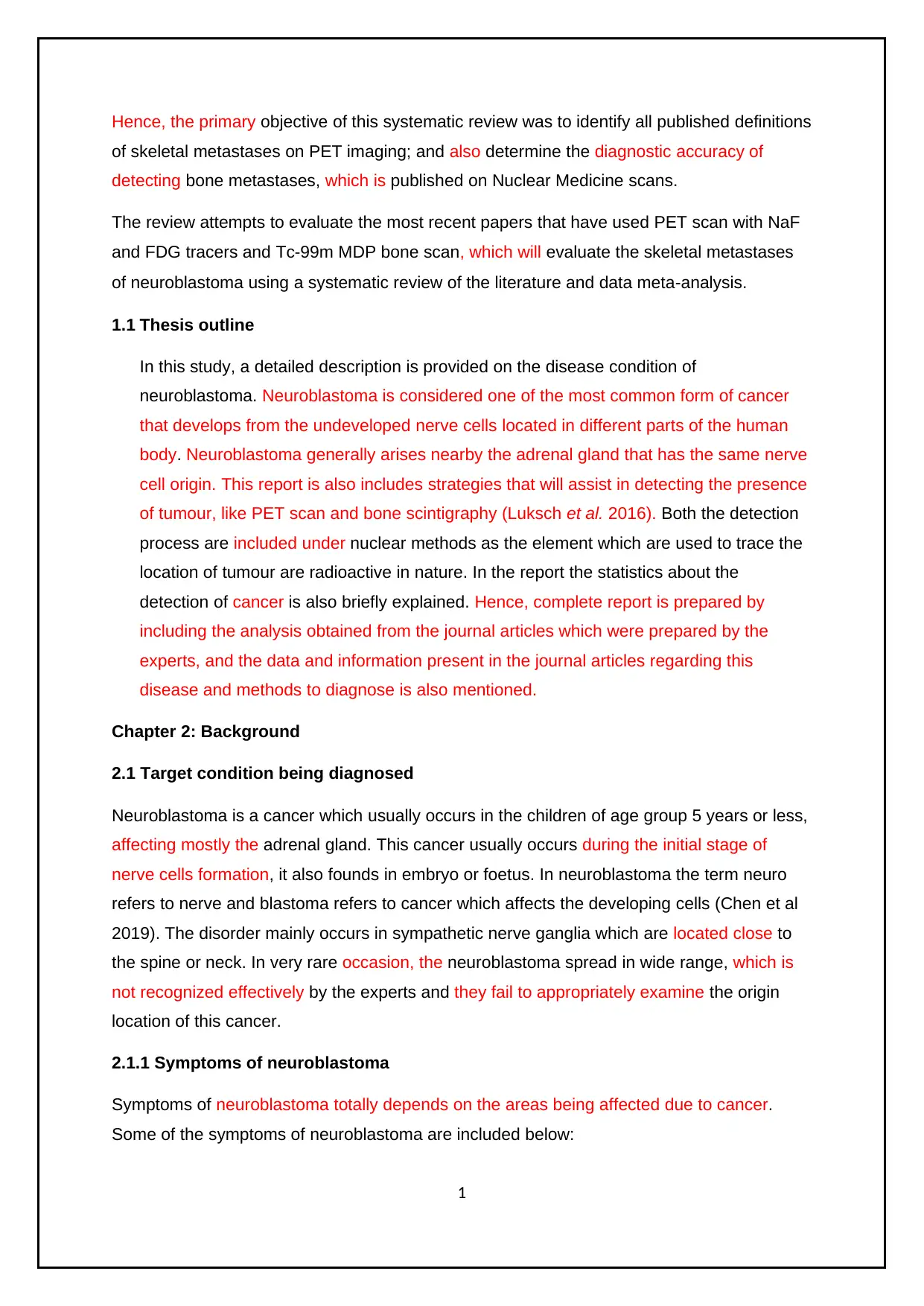
Hence, the primary objective of this systematic review was to identify all published definitions
of skeletal metastases on PET imaging; and also determine the diagnostic accuracy of
detecting bone metastases, which is published on Nuclear Medicine scans.
The review attempts to evaluate the most recent papers that have used PET scan with NaF
and FDG tracers and Tc-99m MDP bone scan, which will evaluate the skeletal metastases
of neuroblastoma using a systematic review of the literature and data meta‐analysis.
1.1 Thesis outline
In this study, a detailed description is provided on the disease condition of
neuroblastoma. Neuroblastoma is considered one of the most common form of cancer
that develops from the undeveloped nerve cells located in different parts of the human
body. Neuroblastoma generally arises nearby the adrenal gland that has the same nerve
cell origin. This report is also includes strategies that will assist in detecting the presence
of tumour, like PET scan and bone scintigraphy (Luksch et al. 2016). Both the detection
process are included under nuclear methods as the element which are used to trace the
location of tumour are radioactive in nature. In the report the statistics about the
detection of cancer is also briefly explained. Hence, complete report is prepared by
including the analysis obtained from the journal articles which were prepared by the
experts, and the data and information present in the journal articles regarding this
disease and methods to diagnose is also mentioned.
Chapter 2: Background
2.1 Target condition being diagnosed
Neuroblastoma is a cancer which usually occurs in the children of age group 5 years or less,
affecting mostly the adrenal gland. This cancer usually occurs during the initial stage of
nerve cells formation, it also founds in embryo or foetus. In neuroblastoma the term neuro
refers to nerve and blastoma refers to cancer which affects the developing cells (Chen et al
2019). The disorder mainly occurs in sympathetic nerve ganglia which are located close to
the spine or neck. In very rare occasion, the neuroblastoma spread in wide range, which is
not recognized effectively by the experts and they fail to appropriately examine the origin
location of this cancer.
2.1.1 Symptoms of neuroblastoma
Symptoms of neuroblastoma totally depends on the areas being affected due to cancer.
Some of the symptoms of neuroblastoma are included below:
1
of skeletal metastases on PET imaging; and also determine the diagnostic accuracy of
detecting bone metastases, which is published on Nuclear Medicine scans.
The review attempts to evaluate the most recent papers that have used PET scan with NaF
and FDG tracers and Tc-99m MDP bone scan, which will evaluate the skeletal metastases
of neuroblastoma using a systematic review of the literature and data meta‐analysis.
1.1 Thesis outline
In this study, a detailed description is provided on the disease condition of
neuroblastoma. Neuroblastoma is considered one of the most common form of cancer
that develops from the undeveloped nerve cells located in different parts of the human
body. Neuroblastoma generally arises nearby the adrenal gland that has the same nerve
cell origin. This report is also includes strategies that will assist in detecting the presence
of tumour, like PET scan and bone scintigraphy (Luksch et al. 2016). Both the detection
process are included under nuclear methods as the element which are used to trace the
location of tumour are radioactive in nature. In the report the statistics about the
detection of cancer is also briefly explained. Hence, complete report is prepared by
including the analysis obtained from the journal articles which were prepared by the
experts, and the data and information present in the journal articles regarding this
disease and methods to diagnose is also mentioned.
Chapter 2: Background
2.1 Target condition being diagnosed
Neuroblastoma is a cancer which usually occurs in the children of age group 5 years or less,
affecting mostly the adrenal gland. This cancer usually occurs during the initial stage of
nerve cells formation, it also founds in embryo or foetus. In neuroblastoma the term neuro
refers to nerve and blastoma refers to cancer which affects the developing cells (Chen et al
2019). The disorder mainly occurs in sympathetic nerve ganglia which are located close to
the spine or neck. In very rare occasion, the neuroblastoma spread in wide range, which is
not recognized effectively by the experts and they fail to appropriately examine the origin
location of this cancer.
2.1.1 Symptoms of neuroblastoma
Symptoms of neuroblastoma totally depends on the areas being affected due to cancer.
Some of the symptoms of neuroblastoma are included below:
1

1. Neuroblastoma in abdomen: Abdominal neuroblastoma is the most common form of
this disorder, and the symptoms observed in this type of Neuroblastoma are included
below:
• Abdominal pain
• Diarrhoea or constipation
• The mass present under skin is not soft when it is touched.
2. Neuroblastoma in chest: The symptoms of this form of neuroblastoma are as follows:
• Wheezing
• Pain in chest
• Unequal size of Pupil, or dropping of eyelids
3. Other associated symptoms which can be observed in neuroblastoma are as follows:
• Clustering of tissue under skin
• Dark circles
• Back pain
• Fever
• Loss of weight
• Pain in bone (Neviani et al. 2019).
2.1.2 Cause of neuroblastoma
Generally, cancer is primarily caused due to mutation affecting the cells that grow and
develop normally. The cancerous cells get multiplied and grow continuously, thereby
resulting in tumour formation within the human body. The condition of neuroblastoma arises
due to a mutation that affects the undeveloped nerve cells of the foetus within the womb.
The cells are further known as neuroblast, and as the child develops with age, the
neuroblast cells also develop and affect the normal functioning of their body. This disorder
arises in immature cells and affect the development of the foetus (Hwang, and Perry, 2019).
2.1.3 Risk Factors
After the detection of cancer, the risk level is classified as Low, medium or high risks. These
risk levels are determined after analysing following factors as mentioned below:
2
this disorder, and the symptoms observed in this type of Neuroblastoma are included
below:
• Abdominal pain
• Diarrhoea or constipation
• The mass present under skin is not soft when it is touched.
2. Neuroblastoma in chest: The symptoms of this form of neuroblastoma are as follows:
• Wheezing
• Pain in chest
• Unequal size of Pupil, or dropping of eyelids
3. Other associated symptoms which can be observed in neuroblastoma are as follows:
• Clustering of tissue under skin
• Dark circles
• Back pain
• Fever
• Loss of weight
• Pain in bone (Neviani et al. 2019).
2.1.2 Cause of neuroblastoma
Generally, cancer is primarily caused due to mutation affecting the cells that grow and
develop normally. The cancerous cells get multiplied and grow continuously, thereby
resulting in tumour formation within the human body. The condition of neuroblastoma arises
due to a mutation that affects the undeveloped nerve cells of the foetus within the womb.
The cells are further known as neuroblast, and as the child develops with age, the
neuroblast cells also develop and affect the normal functioning of their body. This disorder
arises in immature cells and affect the development of the foetus (Hwang, and Perry, 2019).
2.1.3 Risk Factors
After the detection of cancer, the risk level is classified as Low, medium or high risks. These
risk levels are determined after analysing following factors as mentioned below:
2

• Stage of Cancer
• Histology of the Tumour
• Biology of Tumour ‘
• Age of the patient (child) (Nguyen, and Dyer, 2019)
2.1.4 Treatment of Neuroblastoma
Treatment of Neuroblastoma primarily depend upon the age of child and stage of the cancer.
The different types of treatment used for preventing the condition of neuroblastoma are
included as follows:
i. Surgery
ii. Chemotherapy
iii. Radiation Therapy
iv. Immunotherapy
v. Transplant of Stem cell
Chemotherapy: In this type of therapy, anti-cancer drugs are provided to the patient, which
starts killing or destroying the cancerous cells. These drugs are administrated either orally or
through injection as well. There are few side-effects of using this therapy that go away once
the treatments get finished. The side-effects included are as follows: (Ocak, et al. 2019).
• Loss of Hair
• Mouth Sores
• Nausea
• Vomiting
• Immune System will become weak
• Fatigue
Radiation Therapy: In this type of treatment the infected areas are targeted using X-rays,
which are aimed to kill the infected or cancerous cells. This treatment causes many side-
effect which are related to skin i.e. skin irritation diarrhoea, fatigue etc.
Immunotherapy: It is a biological therapy which is used to improve the immune system of
the body in order to fight with disease.
3
• Histology of the Tumour
• Biology of Tumour ‘
• Age of the patient (child) (Nguyen, and Dyer, 2019)
2.1.4 Treatment of Neuroblastoma
Treatment of Neuroblastoma primarily depend upon the age of child and stage of the cancer.
The different types of treatment used for preventing the condition of neuroblastoma are
included as follows:
i. Surgery
ii. Chemotherapy
iii. Radiation Therapy
iv. Immunotherapy
v. Transplant of Stem cell
Chemotherapy: In this type of therapy, anti-cancer drugs are provided to the patient, which
starts killing or destroying the cancerous cells. These drugs are administrated either orally or
through injection as well. There are few side-effects of using this therapy that go away once
the treatments get finished. The side-effects included are as follows: (Ocak, et al. 2019).
• Loss of Hair
• Mouth Sores
• Nausea
• Vomiting
• Immune System will become weak
• Fatigue
Radiation Therapy: In this type of treatment the infected areas are targeted using X-rays,
which are aimed to kill the infected or cancerous cells. This treatment causes many side-
effect which are related to skin i.e. skin irritation diarrhoea, fatigue etc.
Immunotherapy: It is a biological therapy which is used to improve the immune system of
the body in order to fight with disease.
3
Secure Best Marks with AI Grader
Need help grading? Try our AI Grader for instant feedback on your assignments.
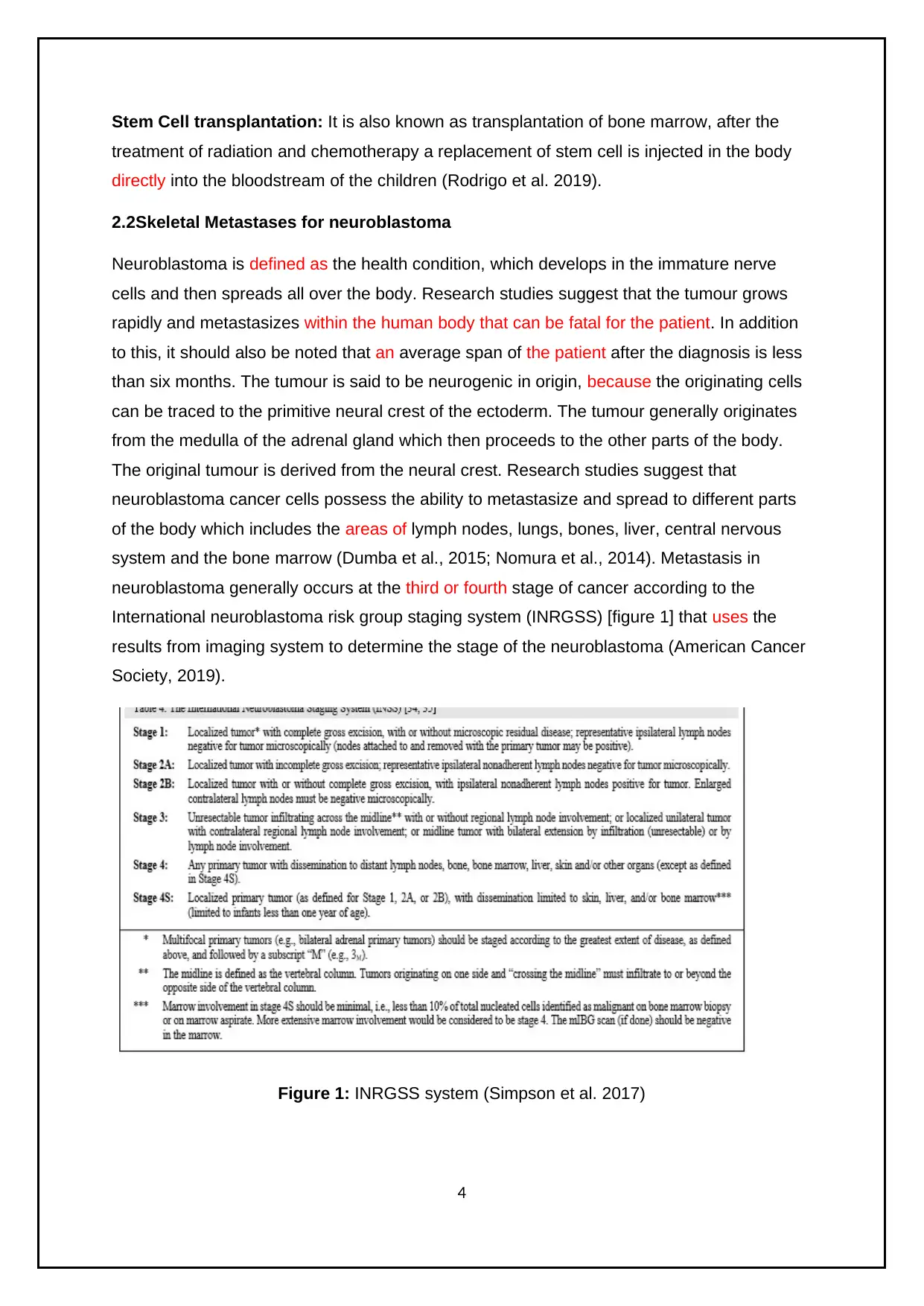
Stem Cell transplantation: It is also known as transplantation of bone marrow, after the
treatment of radiation and chemotherapy a replacement of stem cell is injected in the body
directly into the bloodstream of the children (Rodrigo et al. 2019).
2.2Skeletal Metastases for neuroblastoma
Neuroblastoma is defined as the health condition, which develops in the immature nerve
cells and then spreads all over the body. Research studies suggest that the tumour grows
rapidly and metastasizes within the human body that can be fatal for the patient. In addition
to this, it should also be noted that an average span of the patient after the diagnosis is less
than six months. The tumour is said to be neurogenic in origin, because the originating cells
can be traced to the primitive neural crest of the ectoderm. The tumour generally originates
from the medulla of the adrenal gland which then proceeds to the other parts of the body.
The original tumour is derived from the neural crest. Research studies suggest that
neuroblastoma cancer cells possess the ability to metastasize and spread to different parts
of the body which includes the areas of lymph nodes, lungs, bones, liver, central nervous
system and the bone marrow (Dumba et al., 2015; Nomura et al., 2014). Metastasis in
neuroblastoma generally occurs at the third or fourth stage of cancer according to the
International neuroblastoma risk group staging system (INRGSS) [figure 1] that uses the
results from imaging system to determine the stage of the neuroblastoma (American Cancer
Society, 2019).
Figure 1: INRGSS system (Simpson et al. 2017)
4
treatment of radiation and chemotherapy a replacement of stem cell is injected in the body
directly into the bloodstream of the children (Rodrigo et al. 2019).
2.2Skeletal Metastases for neuroblastoma
Neuroblastoma is defined as the health condition, which develops in the immature nerve
cells and then spreads all over the body. Research studies suggest that the tumour grows
rapidly and metastasizes within the human body that can be fatal for the patient. In addition
to this, it should also be noted that an average span of the patient after the diagnosis is less
than six months. The tumour is said to be neurogenic in origin, because the originating cells
can be traced to the primitive neural crest of the ectoderm. The tumour generally originates
from the medulla of the adrenal gland which then proceeds to the other parts of the body.
The original tumour is derived from the neural crest. Research studies suggest that
neuroblastoma cancer cells possess the ability to metastasize and spread to different parts
of the body which includes the areas of lymph nodes, lungs, bones, liver, central nervous
system and the bone marrow (Dumba et al., 2015; Nomura et al., 2014). Metastasis in
neuroblastoma generally occurs at the third or fourth stage of cancer according to the
International neuroblastoma risk group staging system (INRGSS) [figure 1] that uses the
results from imaging system to determine the stage of the neuroblastoma (American Cancer
Society, 2019).
Figure 1: INRGSS system (Simpson et al. 2017)
4
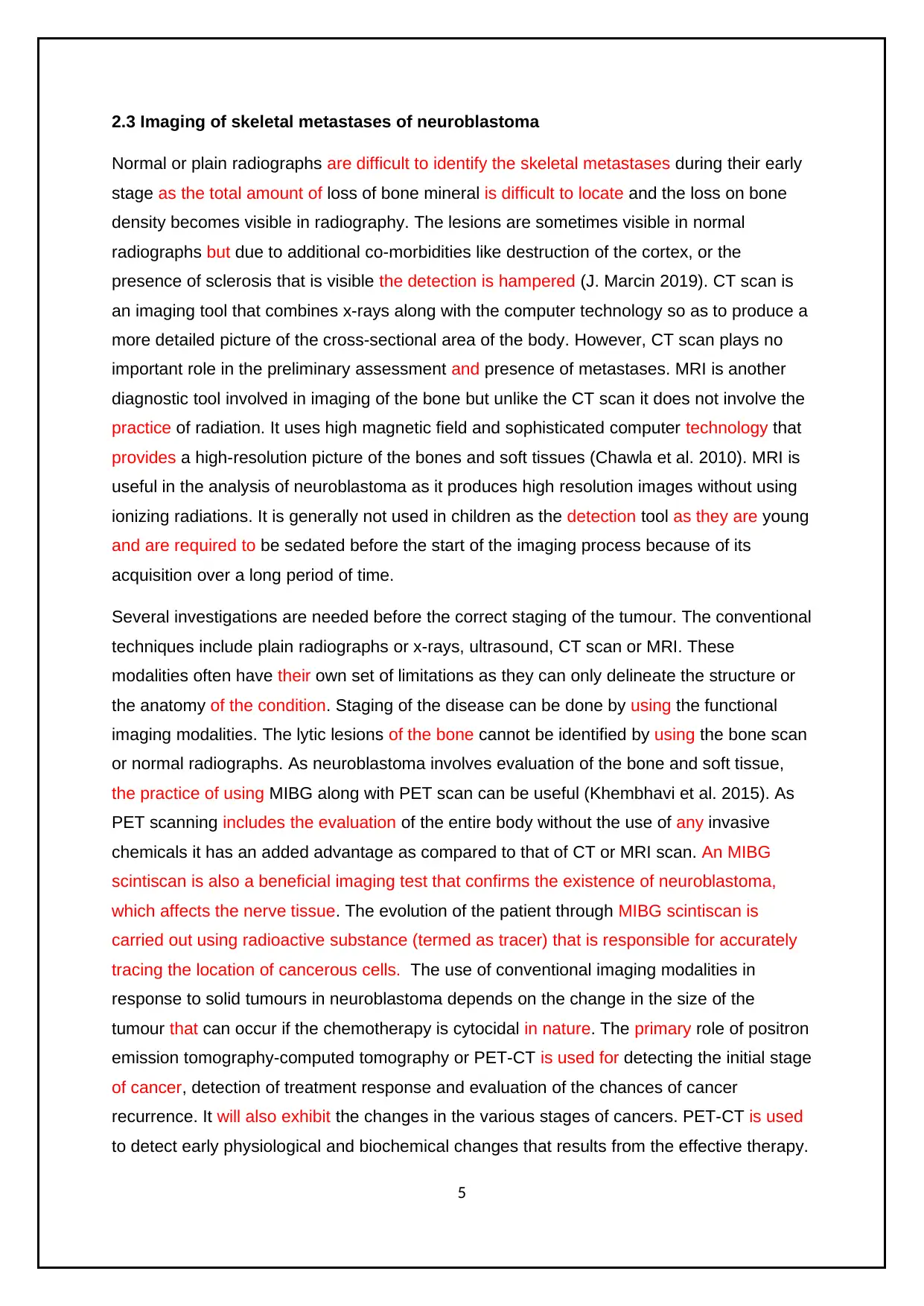
2.3 Imaging of skeletal metastases of neuroblastoma
Normal or plain radiographs are difficult to identify the skeletal metastases during their early
stage as the total amount of loss of bone mineral is difficult to locate and the loss on bone
density becomes visible in radiography. The lesions are sometimes visible in normal
radiographs but due to additional co-morbidities like destruction of the cortex, or the
presence of sclerosis that is visible the detection is hampered (J. Marcin 2019). CT scan is
an imaging tool that combines x-rays along with the computer technology so as to produce a
more detailed picture of the cross-sectional area of the body. However, CT scan plays no
important role in the preliminary assessment and presence of metastases. MRI is another
diagnostic tool involved in imaging of the bone but unlike the CT scan it does not involve the
practice of radiation. It uses high magnetic field and sophisticated computer technology that
provides a high-resolution picture of the bones and soft tissues (Chawla et al. 2010). MRI is
useful in the analysis of neuroblastoma as it produces high resolution images without using
ionizing radiations. It is generally not used in children as the detection tool as they are young
and are required to be sedated before the start of the imaging process because of its
acquisition over a long period of time.
Several investigations are needed before the correct staging of the tumour. The conventional
techniques include plain radiographs or x-rays, ultrasound, CT scan or MRI. These
modalities often have their own set of limitations as they can only delineate the structure or
the anatomy of the condition. Staging of the disease can be done by using the functional
imaging modalities. The lytic lesions of the bone cannot be identified by using the bone scan
or normal radiographs. As neuroblastoma involves evaluation of the bone and soft tissue,
the practice of using MIBG along with PET scan can be useful (Khembhavi et al. 2015). As
PET scanning includes the evaluation of the entire body without the use of any invasive
chemicals it has an added advantage as compared to that of CT or MRI scan. An MIBG
scintiscan is also a beneficial imaging test that confirms the existence of neuroblastoma,
which affects the nerve tissue. The evolution of the patient through MIBG scintiscan is
carried out using radioactive substance (termed as tracer) that is responsible for accurately
tracing the location of cancerous cells. The use of conventional imaging modalities in
response to solid tumours in neuroblastoma depends on the change in the size of the
tumour that can occur if the chemotherapy is cytocidal in nature. The primary role of positron
emission tomography-computed tomography or PET-CT is used for detecting the initial stage
of cancer, detection of treatment response and evaluation of the chances of cancer
recurrence. It will also exhibit the changes in the various stages of cancers. PET-CT is used
to detect early physiological and biochemical changes that results from the effective therapy.
5
Normal or plain radiographs are difficult to identify the skeletal metastases during their early
stage as the total amount of loss of bone mineral is difficult to locate and the loss on bone
density becomes visible in radiography. The lesions are sometimes visible in normal
radiographs but due to additional co-morbidities like destruction of the cortex, or the
presence of sclerosis that is visible the detection is hampered (J. Marcin 2019). CT scan is
an imaging tool that combines x-rays along with the computer technology so as to produce a
more detailed picture of the cross-sectional area of the body. However, CT scan plays no
important role in the preliminary assessment and presence of metastases. MRI is another
diagnostic tool involved in imaging of the bone but unlike the CT scan it does not involve the
practice of radiation. It uses high magnetic field and sophisticated computer technology that
provides a high-resolution picture of the bones and soft tissues (Chawla et al. 2010). MRI is
useful in the analysis of neuroblastoma as it produces high resolution images without using
ionizing radiations. It is generally not used in children as the detection tool as they are young
and are required to be sedated before the start of the imaging process because of its
acquisition over a long period of time.
Several investigations are needed before the correct staging of the tumour. The conventional
techniques include plain radiographs or x-rays, ultrasound, CT scan or MRI. These
modalities often have their own set of limitations as they can only delineate the structure or
the anatomy of the condition. Staging of the disease can be done by using the functional
imaging modalities. The lytic lesions of the bone cannot be identified by using the bone scan
or normal radiographs. As neuroblastoma involves evaluation of the bone and soft tissue,
the practice of using MIBG along with PET scan can be useful (Khembhavi et al. 2015). As
PET scanning includes the evaluation of the entire body without the use of any invasive
chemicals it has an added advantage as compared to that of CT or MRI scan. An MIBG
scintiscan is also a beneficial imaging test that confirms the existence of neuroblastoma,
which affects the nerve tissue. The evolution of the patient through MIBG scintiscan is
carried out using radioactive substance (termed as tracer) that is responsible for accurately
tracing the location of cancerous cells. The use of conventional imaging modalities in
response to solid tumours in neuroblastoma depends on the change in the size of the
tumour that can occur if the chemotherapy is cytocidal in nature. The primary role of positron
emission tomography-computed tomography or PET-CT is used for detecting the initial stage
of cancer, detection of treatment response and evaluation of the chances of cancer
recurrence. It will also exhibit the changes in the various stages of cancers. PET-CT is used
to detect early physiological and biochemical changes that results from the effective therapy.
5
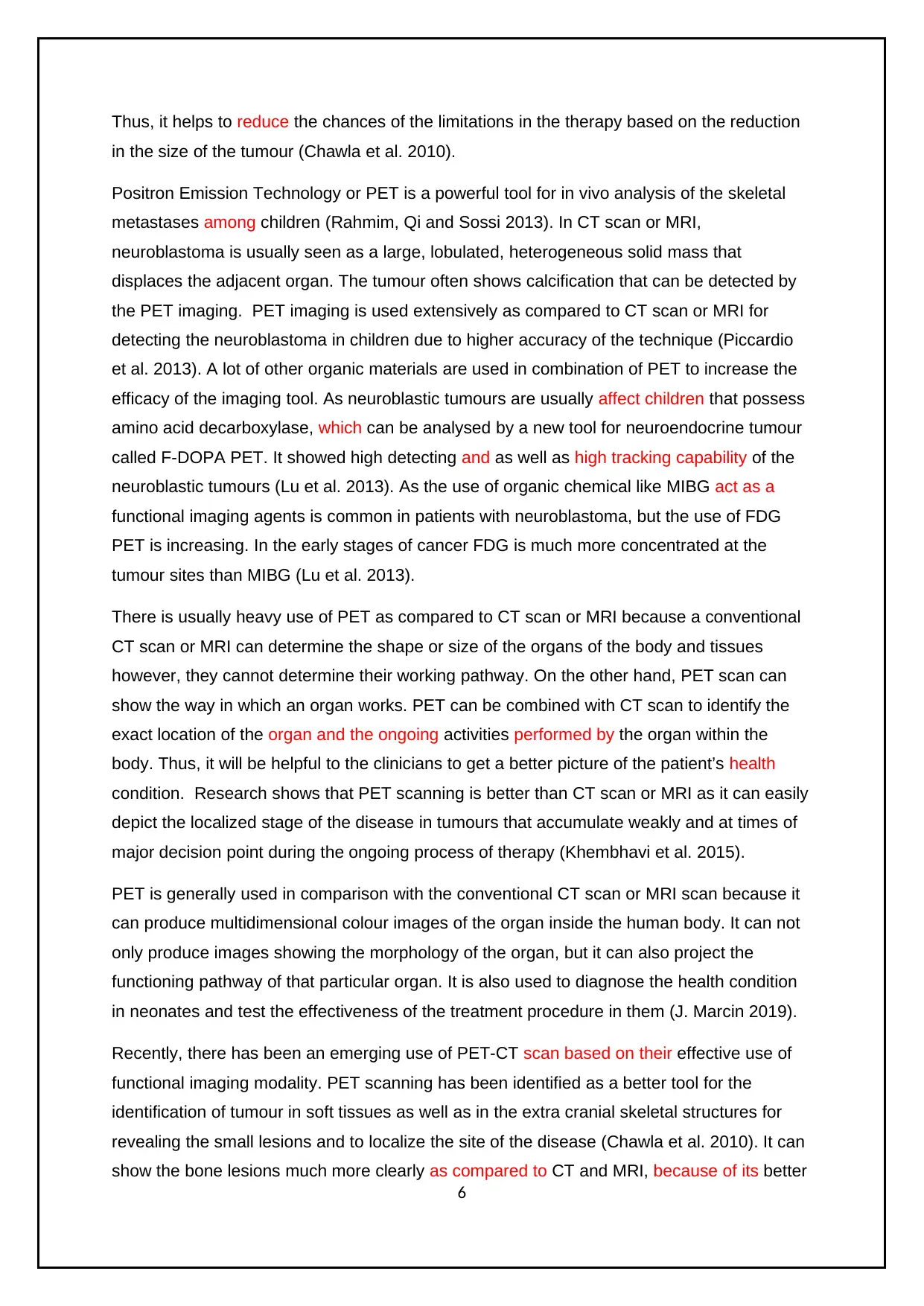
Thus, it helps to reduce the chances of the limitations in the therapy based on the reduction
in the size of the tumour (Chawla et al. 2010).
Positron Emission Technology or PET is a powerful tool for in vivo analysis of the skeletal
metastases among children (Rahmim, Qi and Sossi 2013). In CT scan or MRI,
neuroblastoma is usually seen as a large, lobulated, heterogeneous solid mass that
displaces the adjacent organ. The tumour often shows calcification that can be detected by
the PET imaging. PET imaging is used extensively as compared to CT scan or MRI for
detecting the neuroblastoma in children due to higher accuracy of the technique (Piccardio
et al. 2013). A lot of other organic materials are used in combination of PET to increase the
efficacy of the imaging tool. As neuroblastic tumours are usually affect children that possess
amino acid decarboxylase, which can be analysed by a new tool for neuroendocrine tumour
called F-DOPA PET. It showed high detecting and as well as high tracking capability of the
neuroblastic tumours (Lu et al. 2013). As the use of organic chemical like MIBG act as a
functional imaging agents is common in patients with neuroblastoma, but the use of FDG
PET is increasing. In the early stages of cancer FDG is much more concentrated at the
tumour sites than MIBG (Lu et al. 2013).
There is usually heavy use of PET as compared to CT scan or MRI because a conventional
CT scan or MRI can determine the shape or size of the organs of the body and tissues
however, they cannot determine their working pathway. On the other hand, PET scan can
show the way in which an organ works. PET can be combined with CT scan to identify the
exact location of the organ and the ongoing activities performed by the organ within the
body. Thus, it will be helpful to the clinicians to get a better picture of the patient’s health
condition. Research shows that PET scanning is better than CT scan or MRI as it can easily
depict the localized stage of the disease in tumours that accumulate weakly and at times of
major decision point during the ongoing process of therapy (Khembhavi et al. 2015).
PET is generally used in comparison with the conventional CT scan or MRI scan because it
can produce multidimensional colour images of the organ inside the human body. It can not
only produce images showing the morphology of the organ, but it can also project the
functioning pathway of that particular organ. It is also used to diagnose the health condition
in neonates and test the effectiveness of the treatment procedure in them (J. Marcin 2019).
Recently, there has been an emerging use of PET-CT scan based on their effective use of
functional imaging modality. PET scanning has been identified as a better tool for the
identification of tumour in soft tissues as well as in the extra cranial skeletal structures for
revealing the small lesions and to localize the site of the disease (Chawla et al. 2010). It can
show the bone lesions much more clearly as compared to CT and MRI, because of its better
6
in the size of the tumour (Chawla et al. 2010).
Positron Emission Technology or PET is a powerful tool for in vivo analysis of the skeletal
metastases among children (Rahmim, Qi and Sossi 2013). In CT scan or MRI,
neuroblastoma is usually seen as a large, lobulated, heterogeneous solid mass that
displaces the adjacent organ. The tumour often shows calcification that can be detected by
the PET imaging. PET imaging is used extensively as compared to CT scan or MRI for
detecting the neuroblastoma in children due to higher accuracy of the technique (Piccardio
et al. 2013). A lot of other organic materials are used in combination of PET to increase the
efficacy of the imaging tool. As neuroblastic tumours are usually affect children that possess
amino acid decarboxylase, which can be analysed by a new tool for neuroendocrine tumour
called F-DOPA PET. It showed high detecting and as well as high tracking capability of the
neuroblastic tumours (Lu et al. 2013). As the use of organic chemical like MIBG act as a
functional imaging agents is common in patients with neuroblastoma, but the use of FDG
PET is increasing. In the early stages of cancer FDG is much more concentrated at the
tumour sites than MIBG (Lu et al. 2013).
There is usually heavy use of PET as compared to CT scan or MRI because a conventional
CT scan or MRI can determine the shape or size of the organs of the body and tissues
however, they cannot determine their working pathway. On the other hand, PET scan can
show the way in which an organ works. PET can be combined with CT scan to identify the
exact location of the organ and the ongoing activities performed by the organ within the
body. Thus, it will be helpful to the clinicians to get a better picture of the patient’s health
condition. Research shows that PET scanning is better than CT scan or MRI as it can easily
depict the localized stage of the disease in tumours that accumulate weakly and at times of
major decision point during the ongoing process of therapy (Khembhavi et al. 2015).
PET is generally used in comparison with the conventional CT scan or MRI scan because it
can produce multidimensional colour images of the organ inside the human body. It can not
only produce images showing the morphology of the organ, but it can also project the
functioning pathway of that particular organ. It is also used to diagnose the health condition
in neonates and test the effectiveness of the treatment procedure in them (J. Marcin 2019).
Recently, there has been an emerging use of PET-CT scan based on their effective use of
functional imaging modality. PET scanning has been identified as a better tool for the
identification of tumour in soft tissues as well as in the extra cranial skeletal structures for
revealing the small lesions and to localize the site of the disease (Chawla et al. 2010). It can
show the bone lesions much more clearly as compared to CT and MRI, because of its better
6
Paraphrase This Document
Need a fresh take? Get an instant paraphrase of this document with our AI Paraphraser
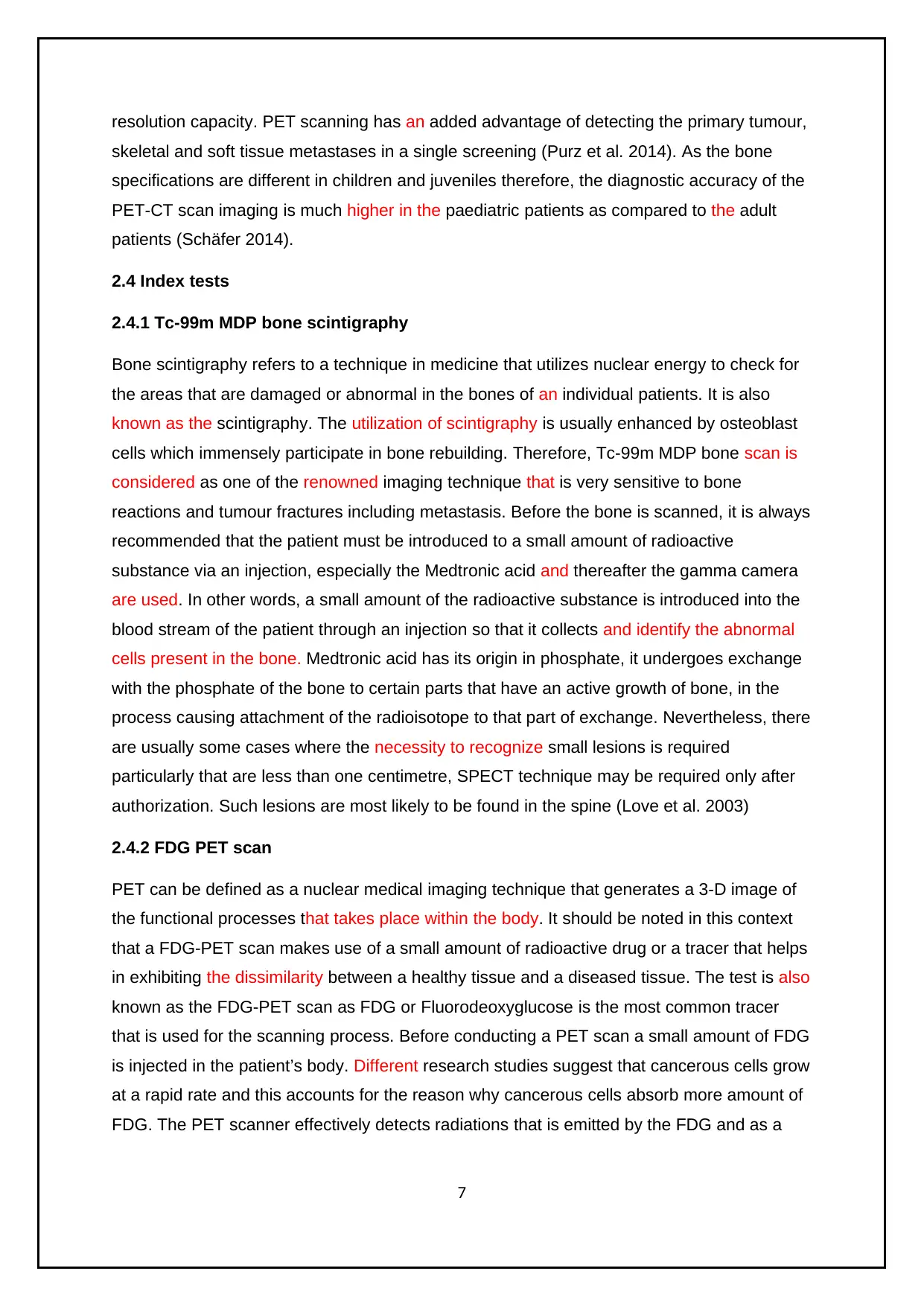
resolution capacity. PET scanning has an added advantage of detecting the primary tumour,
skeletal and soft tissue metastases in a single screening (Purz et al. 2014). As the bone
specifications are different in children and juveniles therefore, the diagnostic accuracy of the
PET-CT scan imaging is much higher in the paediatric patients as compared to the adult
patients (Schäfer 2014).
2.4 Index tests
2.4.1 Tc-99m MDP bone scintigraphy
Bone scintigraphy refers to a technique in medicine that utilizes nuclear energy to check for
the areas that are damaged or abnormal in the bones of an individual patients. It is also
known as the scintigraphy. The utilization of scintigraphy is usually enhanced by osteoblast
cells which immensely participate in bone rebuilding. Therefore, Tc-99m MDP bone scan is
considered as one of the renowned imaging technique that is very sensitive to bone
reactions and tumour fractures including metastasis. Before the bone is scanned, it is always
recommended that the patient must be introduced to a small amount of radioactive
substance via an injection, especially the Medtronic acid and thereafter the gamma camera
are used. In other words, a small amount of the radioactive substance is introduced into the
blood stream of the patient through an injection so that it collects and identify the abnormal
cells present in the bone. Medtronic acid has its origin in phosphate, it undergoes exchange
with the phosphate of the bone to certain parts that have an active growth of bone, in the
process causing attachment of the radioisotope to that part of exchange. Nevertheless, there
are usually some cases where the necessity to recognize small lesions is required
particularly that are less than one centimetre, SPECT technique may be required only after
authorization. Such lesions are most likely to be found in the spine (Love et al. 2003)
2.4.2 FDG PET scan
PET can be defined as a nuclear medical imaging technique that generates a 3-D image of
the functional processes that takes place within the body. It should be noted in this context
that a FDG-PET scan makes use of a small amount of radioactive drug or a tracer that helps
in exhibiting the dissimilarity between a healthy tissue and a diseased tissue. The test is also
known as the FDG-PET scan as FDG or Fluorodeoxyglucose is the most common tracer
that is used for the scanning process. Before conducting a PET scan a small amount of FDG
is injected in the patient’s body. Different research studies suggest that cancerous cells grow
at a rapid rate and this accounts for the reason why cancerous cells absorb more amount of
FDG. The PET scanner effectively detects radiations that is emitted by the FDG and as a
7
skeletal and soft tissue metastases in a single screening (Purz et al. 2014). As the bone
specifications are different in children and juveniles therefore, the diagnostic accuracy of the
PET-CT scan imaging is much higher in the paediatric patients as compared to the adult
patients (Schäfer 2014).
2.4 Index tests
2.4.1 Tc-99m MDP bone scintigraphy
Bone scintigraphy refers to a technique in medicine that utilizes nuclear energy to check for
the areas that are damaged or abnormal in the bones of an individual patients. It is also
known as the scintigraphy. The utilization of scintigraphy is usually enhanced by osteoblast
cells which immensely participate in bone rebuilding. Therefore, Tc-99m MDP bone scan is
considered as one of the renowned imaging technique that is very sensitive to bone
reactions and tumour fractures including metastasis. Before the bone is scanned, it is always
recommended that the patient must be introduced to a small amount of radioactive
substance via an injection, especially the Medtronic acid and thereafter the gamma camera
are used. In other words, a small amount of the radioactive substance is introduced into the
blood stream of the patient through an injection so that it collects and identify the abnormal
cells present in the bone. Medtronic acid has its origin in phosphate, it undergoes exchange
with the phosphate of the bone to certain parts that have an active growth of bone, in the
process causing attachment of the radioisotope to that part of exchange. Nevertheless, there
are usually some cases where the necessity to recognize small lesions is required
particularly that are less than one centimetre, SPECT technique may be required only after
authorization. Such lesions are most likely to be found in the spine (Love et al. 2003)
2.4.2 FDG PET scan
PET can be defined as a nuclear medical imaging technique that generates a 3-D image of
the functional processes that takes place within the body. It should be noted in this context
that a FDG-PET scan makes use of a small amount of radioactive drug or a tracer that helps
in exhibiting the dissimilarity between a healthy tissue and a diseased tissue. The test is also
known as the FDG-PET scan as FDG or Fluorodeoxyglucose is the most common tracer
that is used for the scanning process. Before conducting a PET scan a small amount of FDG
is injected in the patient’s body. Different research studies suggest that cancerous cells grow
at a rapid rate and this accounts for the reason why cancerous cells absorb more amount of
FDG. The PET scanner effectively detects radiations that is emitted by the FDG and as a
7
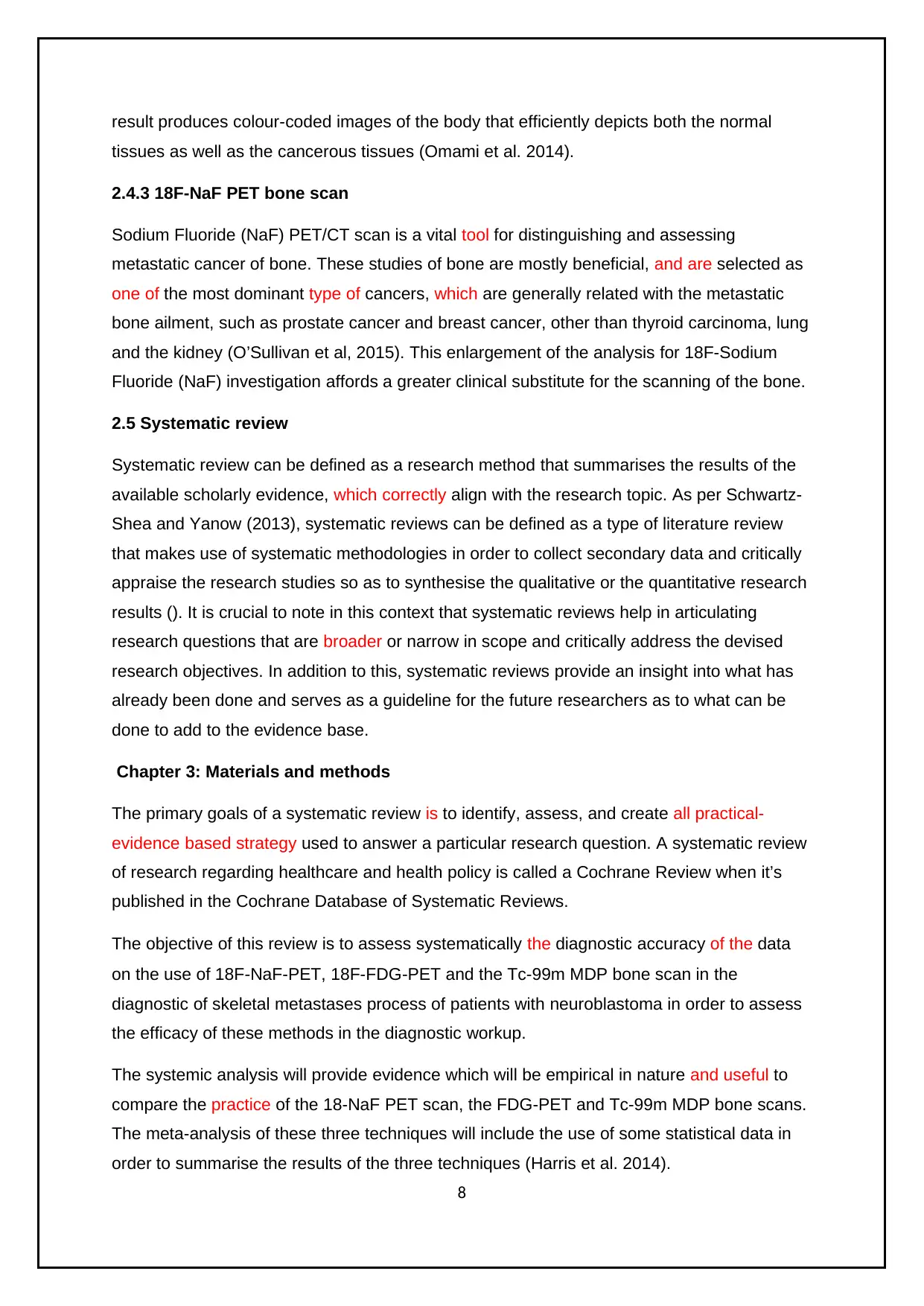
result produces colour-coded images of the body that efficiently depicts both the normal
tissues as well as the cancerous tissues (Omami et al. 2014).
2.4.3 18F-NaF PET bone scan
Sodium Fluoride (NaF) PET/CT scan is a vital tool for distinguishing and assessing
metastatic cancer of bone. These studies of bone are mostly beneficial, and are selected as
one of the most dominant type of cancers, which are generally related with the metastatic
bone ailment, such as prostate cancer and breast cancer, other than thyroid carcinoma, lung
and the kidney (O’Sullivan et al, 2015). This enlargement of the analysis for 18F-Sodium
Fluoride (NaF) investigation affords a greater clinical substitute for the scanning of the bone.
2.5 Systematic review
Systematic review can be defined as a research method that summarises the results of the
available scholarly evidence, which correctly align with the research topic. As per Schwartz-
Shea and Yanow (2013), systematic reviews can be defined as a type of literature review
that makes use of systematic methodologies in order to collect secondary data and critically
appraise the research studies so as to synthesise the qualitative or the quantitative research
results (). It is crucial to note in this context that systematic reviews help in articulating
research questions that are broader or narrow in scope and critically address the devised
research objectives. In addition to this, systematic reviews provide an insight into what has
already been done and serves as a guideline for the future researchers as to what can be
done to add to the evidence base.
Chapter 3: Materials and methods
The primary goals of a systematic review is to identify, assess, and create all practical-
evidence based strategy used to answer a particular research question. A systematic review
of research regarding healthcare and health policy is called a Cochrane Review when it’s
published in the Cochrane Database of Systematic Reviews.
The objective of this review is to assess systematically the diagnostic accuracy of the data
on the use of 18F‐NaF-PET, 18F-FDG‐PET and the Tc-99m MDP bone scan in the
diagnostic of skeletal metastases process of patients with neuroblastoma in order to assess
the efficacy of these methods in the diagnostic workup.
The systemic analysis will provide evidence which will be empirical in nature and useful to
compare the practice of the 18-NaF PET scan, the FDG-PET and Tc-99m MDP bone scans.
The meta-analysis of these three techniques will include the use of some statistical data in
order to summarise the results of the three techniques (Harris et al. 2014).
8
tissues as well as the cancerous tissues (Omami et al. 2014).
2.4.3 18F-NaF PET bone scan
Sodium Fluoride (NaF) PET/CT scan is a vital tool for distinguishing and assessing
metastatic cancer of bone. These studies of bone are mostly beneficial, and are selected as
one of the most dominant type of cancers, which are generally related with the metastatic
bone ailment, such as prostate cancer and breast cancer, other than thyroid carcinoma, lung
and the kidney (O’Sullivan et al, 2015). This enlargement of the analysis for 18F-Sodium
Fluoride (NaF) investigation affords a greater clinical substitute for the scanning of the bone.
2.5 Systematic review
Systematic review can be defined as a research method that summarises the results of the
available scholarly evidence, which correctly align with the research topic. As per Schwartz-
Shea and Yanow (2013), systematic reviews can be defined as a type of literature review
that makes use of systematic methodologies in order to collect secondary data and critically
appraise the research studies so as to synthesise the qualitative or the quantitative research
results (). It is crucial to note in this context that systematic reviews help in articulating
research questions that are broader or narrow in scope and critically address the devised
research objectives. In addition to this, systematic reviews provide an insight into what has
already been done and serves as a guideline for the future researchers as to what can be
done to add to the evidence base.
Chapter 3: Materials and methods
The primary goals of a systematic review is to identify, assess, and create all practical-
evidence based strategy used to answer a particular research question. A systematic review
of research regarding healthcare and health policy is called a Cochrane Review when it’s
published in the Cochrane Database of Systematic Reviews.
The objective of this review is to assess systematically the diagnostic accuracy of the data
on the use of 18F‐NaF-PET, 18F-FDG‐PET and the Tc-99m MDP bone scan in the
diagnostic of skeletal metastases process of patients with neuroblastoma in order to assess
the efficacy of these methods in the diagnostic workup.
The systemic analysis will provide evidence which will be empirical in nature and useful to
compare the practice of the 18-NaF PET scan, the FDG-PET and Tc-99m MDP bone scans.
The meta-analysis of these three techniques will include the use of some statistical data in
order to summarise the results of the three techniques (Harris et al. 2014).
8

3.1 Cochrane review
The guidelines for conducting a Cochrane Review involves various steps to which the data
must be subjected. The first step is to identify relevant studies from different range of data
presented regarding the topic of study (Storebø et al. 2015, p.h5203). Once the survey has
been identified, its provisions are then selected, and the most appropriate issues are
included and evaluated based on the pros, cons, and clarity of the criteria. The third step is
the systematic collection of data whose primary purpose is to maintain relevancy and reduce
the percentage biasness of the data. The final step is to ensure that the data is appropriately
synthesized.
3.2 The research question frame
The model which is used to define clinical observations is practiced using the method of
analysing medical problem, which helps to provide support to specific patient from his/her
observations. Basically, this model is used to prepare the design strategies for observations
or literature. Here PICO stands for:
Parameter Description
P (Patient, Problem) Children who are suffering from Neuroblastoma, it was observed
that this cancer is migrated to the bone.
I (Intervention) Evaluation by PET scan and MIBG scintigraphy
C (Comparison) NaF, FDG PET and Tc-99m MDP bone scan
O (Outcomes) Metastases of Neuroblastoma in bone.
3.3 Search Strategy
The search strategy is the method that utilises definite key words to examine any database
in constructive pattern. This process helps to obtain an accurate results by combining the
main concepts of the searched question.
3.3.1 Published Databases
The databases which are already published in the form of article, journals, newspapers or
reports by the experts of the topic are included under published databases. These
databases are prepared by the extensive research that is conducted on the study using
different strategies and applying different methods. These methods are practically and
theoretically analysed with the prior facts and all the necessary data related to subject. The
9
The guidelines for conducting a Cochrane Review involves various steps to which the data
must be subjected. The first step is to identify relevant studies from different range of data
presented regarding the topic of study (Storebø et al. 2015, p.h5203). Once the survey has
been identified, its provisions are then selected, and the most appropriate issues are
included and evaluated based on the pros, cons, and clarity of the criteria. The third step is
the systematic collection of data whose primary purpose is to maintain relevancy and reduce
the percentage biasness of the data. The final step is to ensure that the data is appropriately
synthesized.
3.2 The research question frame
The model which is used to define clinical observations is practiced using the method of
analysing medical problem, which helps to provide support to specific patient from his/her
observations. Basically, this model is used to prepare the design strategies for observations
or literature. Here PICO stands for:
Parameter Description
P (Patient, Problem) Children who are suffering from Neuroblastoma, it was observed
that this cancer is migrated to the bone.
I (Intervention) Evaluation by PET scan and MIBG scintigraphy
C (Comparison) NaF, FDG PET and Tc-99m MDP bone scan
O (Outcomes) Metastases of Neuroblastoma in bone.
3.3 Search Strategy
The search strategy is the method that utilises definite key words to examine any database
in constructive pattern. This process helps to obtain an accurate results by combining the
main concepts of the searched question.
3.3.1 Published Databases
The databases which are already published in the form of article, journals, newspapers or
reports by the experts of the topic are included under published databases. These
databases are prepared by the extensive research that is conducted on the study using
different strategies and applying different methods. These methods are practically and
theoretically analysed with the prior facts and all the necessary data related to subject. The
9
Secure Best Marks with AI Grader
Need help grading? Try our AI Grader for instant feedback on your assignments.
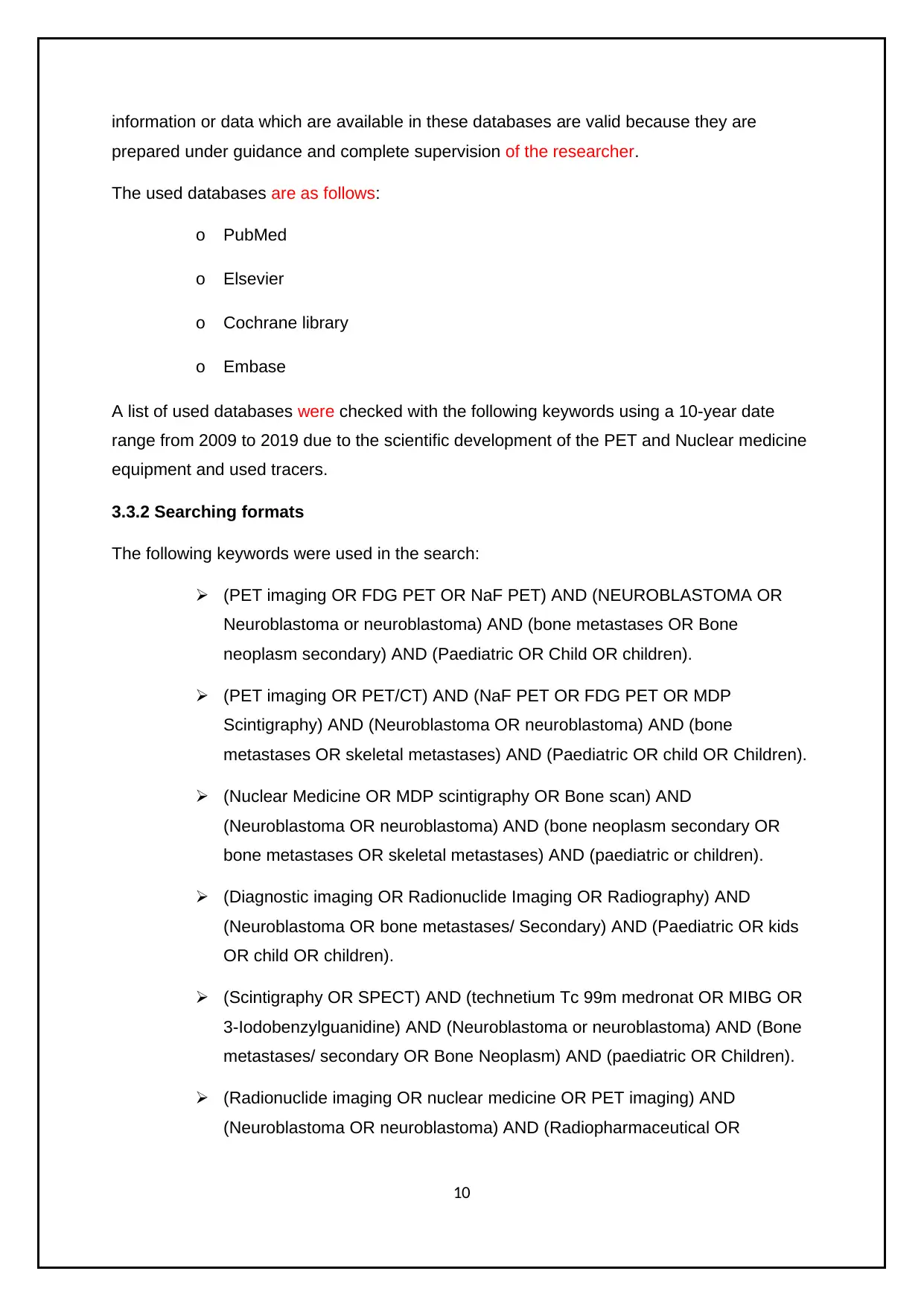
information or data which are available in these databases are valid because they are
prepared under guidance and complete supervision of the researcher.
The used databases are as follows:
o PubMed
o Elsevier
o Cochrane library
o Embase
A list of used databases were checked with the following keywords using a 10-year date
range from 2009 to 2019 due to the scientific development of the PET and Nuclear medicine
equipment and used tracers.
3.3.2 Searching formats
The following keywords were used in the search:
(PET imaging OR FDG PET OR NaF PET) AND (NEUROBLASTOMA OR
Neuroblastoma or neuroblastoma) AND (bone metastases OR Bone
neoplasm secondary) AND (Paediatric OR Child OR children).
(PET imaging OR PET/CT) AND (NaF PET OR FDG PET OR MDP
Scintigraphy) AND (Neuroblastoma OR neuroblastoma) AND (bone
metastases OR skeletal metastases) AND (Paediatric OR child OR Children).
(Nuclear Medicine OR MDP scintigraphy OR Bone scan) AND
(Neuroblastoma OR neuroblastoma) AND (bone neoplasm secondary OR
bone metastases OR skeletal metastases) AND (paediatric or children).
(Diagnostic imaging OR Radionuclide Imaging OR Radiography) AND
(Neuroblastoma OR bone metastases/ Secondary) AND (Paediatric OR kids
OR child OR children).
(Scintigraphy OR SPECT) AND (technetium Tc 99m medronat OR MIBG OR
3-Iodobenzylguanidine) AND (Neuroblastoma or neuroblastoma) AND (Bone
metastases/ secondary OR Bone Neoplasm) AND (paediatric OR Children).
(Radionuclide imaging OR nuclear medicine OR PET imaging) AND
(Neuroblastoma OR neuroblastoma) AND (Radiopharmaceutical OR
10
prepared under guidance and complete supervision of the researcher.
The used databases are as follows:
o PubMed
o Elsevier
o Cochrane library
o Embase
A list of used databases were checked with the following keywords using a 10-year date
range from 2009 to 2019 due to the scientific development of the PET and Nuclear medicine
equipment and used tracers.
3.3.2 Searching formats
The following keywords were used in the search:
(PET imaging OR FDG PET OR NaF PET) AND (NEUROBLASTOMA OR
Neuroblastoma or neuroblastoma) AND (bone metastases OR Bone
neoplasm secondary) AND (Paediatric OR Child OR children).
(PET imaging OR PET/CT) AND (NaF PET OR FDG PET OR MDP
Scintigraphy) AND (Neuroblastoma OR neuroblastoma) AND (bone
metastases OR skeletal metastases) AND (Paediatric OR child OR Children).
(Nuclear Medicine OR MDP scintigraphy OR Bone scan) AND
(Neuroblastoma OR neuroblastoma) AND (bone neoplasm secondary OR
bone metastases OR skeletal metastases) AND (paediatric or children).
(Diagnostic imaging OR Radionuclide Imaging OR Radiography) AND
(Neuroblastoma OR bone metastases/ Secondary) AND (Paediatric OR kids
OR child OR children).
(Scintigraphy OR SPECT) AND (technetium Tc 99m medronat OR MIBG OR
3-Iodobenzylguanidine) AND (Neuroblastoma or neuroblastoma) AND (Bone
metastases/ secondary OR Bone Neoplasm) AND (paediatric OR Children).
(Radionuclide imaging OR nuclear medicine OR PET imaging) AND
(Neuroblastoma OR neuroblastoma) AND (Radiopharmaceutical OR
10
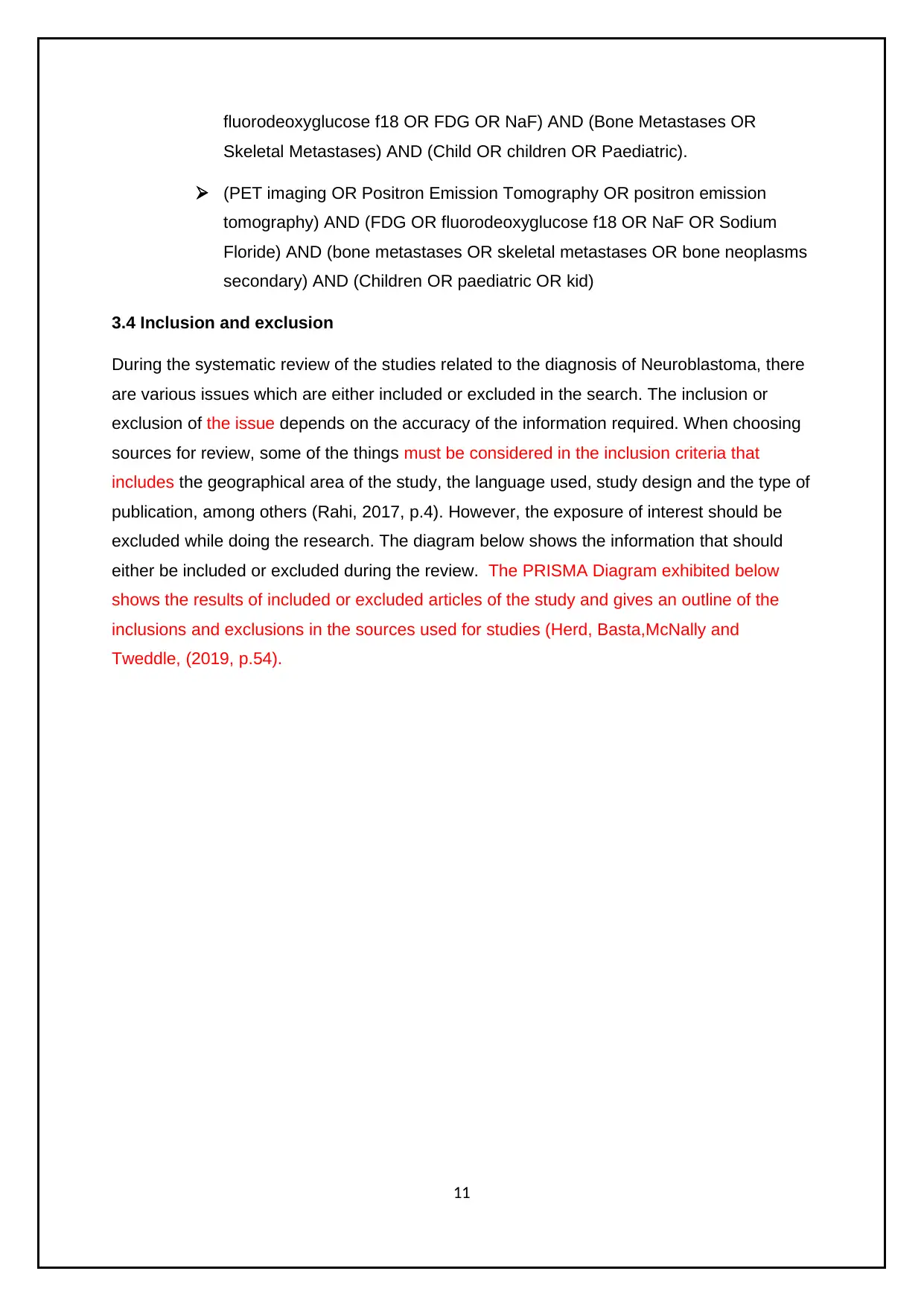
fluorodeoxyglucose f18 OR FDG OR NaF) AND (Bone Metastases OR
Skeletal Metastases) AND (Child OR children OR Paediatric).
(PET imaging OR Positron Emission Tomography OR positron emission
tomography) AND (FDG OR fluorodeoxyglucose f18 OR NaF OR Sodium
Floride) AND (bone metastases OR skeletal metastases OR bone neoplasms
secondary) AND (Children OR paediatric OR kid)
3.4 Inclusion and exclusion
During the systematic review of the studies related to the diagnosis of Neuroblastoma, there
are various issues which are either included or excluded in the search. The inclusion or
exclusion of the issue depends on the accuracy of the information required. When choosing
sources for review, some of the things must be considered in the inclusion criteria that
includes the geographical area of the study, the language used, study design and the type of
publication, among others (Rahi, 2017, p.4). However, the exposure of interest should be
excluded while doing the research. The diagram below shows the information that should
either be included or excluded during the review. The PRISMA Diagram exhibited below
shows the results of included or excluded articles of the study and gives an outline of the
inclusions and exclusions in the sources used for studies (Herd, Basta,McNally and
Tweddle, (2019, p.54).
11
Skeletal Metastases) AND (Child OR children OR Paediatric).
(PET imaging OR Positron Emission Tomography OR positron emission
tomography) AND (FDG OR fluorodeoxyglucose f18 OR NaF OR Sodium
Floride) AND (bone metastases OR skeletal metastases OR bone neoplasms
secondary) AND (Children OR paediatric OR kid)
3.4 Inclusion and exclusion
During the systematic review of the studies related to the diagnosis of Neuroblastoma, there
are various issues which are either included or excluded in the search. The inclusion or
exclusion of the issue depends on the accuracy of the information required. When choosing
sources for review, some of the things must be considered in the inclusion criteria that
includes the geographical area of the study, the language used, study design and the type of
publication, among others (Rahi, 2017, p.4). However, the exposure of interest should be
excluded while doing the research. The diagram below shows the information that should
either be included or excluded during the review. The PRISMA Diagram exhibited below
shows the results of included or excluded articles of the study and gives an outline of the
inclusions and exclusions in the sources used for studies (Herd, Basta,McNally and
Tweddle, (2019, p.54).
11
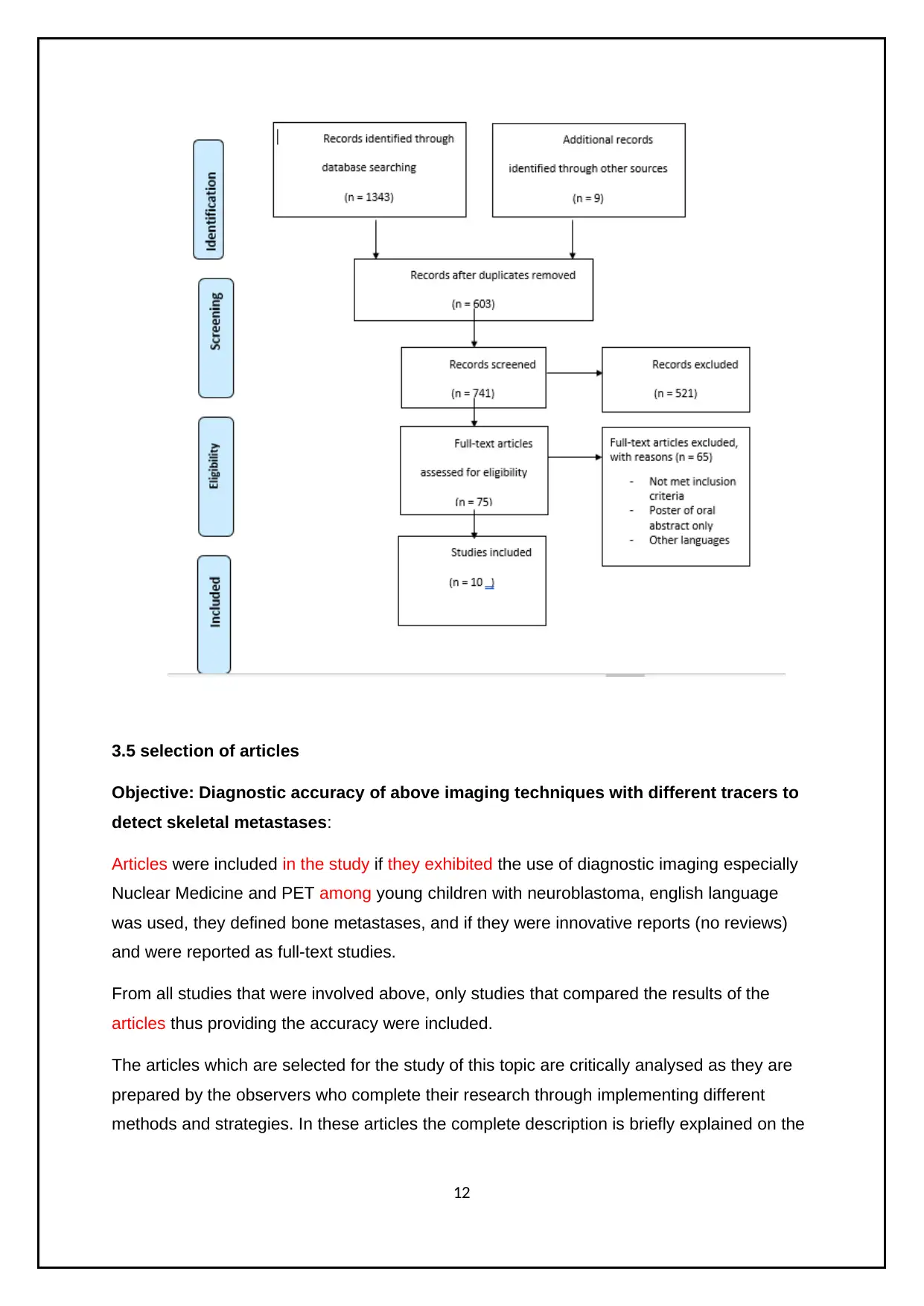
3.5 selection of articles
Objective: Diagnostic accuracy of above imaging techniques with different tracers to
detect skeletal metastases:
Articles were included in the study if they exhibited the use of diagnostic imaging especially
Nuclear Medicine and PET among young children with neuroblastoma, english language
was used, they defined bone metastases, and if they were innovative reports (no reviews)
and were reported as full-text studies.
From all studies that were involved above, only studies that compared the results of the
articles thus providing the accuracy were included.
The articles which are selected for the study of this topic are critically analysed as they are
prepared by the observers who complete their research through implementing different
methods and strategies. In these articles the complete description is briefly explained on the
12
Objective: Diagnostic accuracy of above imaging techniques with different tracers to
detect skeletal metastases:
Articles were included in the study if they exhibited the use of diagnostic imaging especially
Nuclear Medicine and PET among young children with neuroblastoma, english language
was used, they defined bone metastases, and if they were innovative reports (no reviews)
and were reported as full-text studies.
From all studies that were involved above, only studies that compared the results of the
articles thus providing the accuracy were included.
The articles which are selected for the study of this topic are critically analysed as they are
prepared by the observers who complete their research through implementing different
methods and strategies. In these articles the complete description is briefly explained on the
12
Paraphrase This Document
Need a fresh take? Get an instant paraphrase of this document with our AI Paraphraser
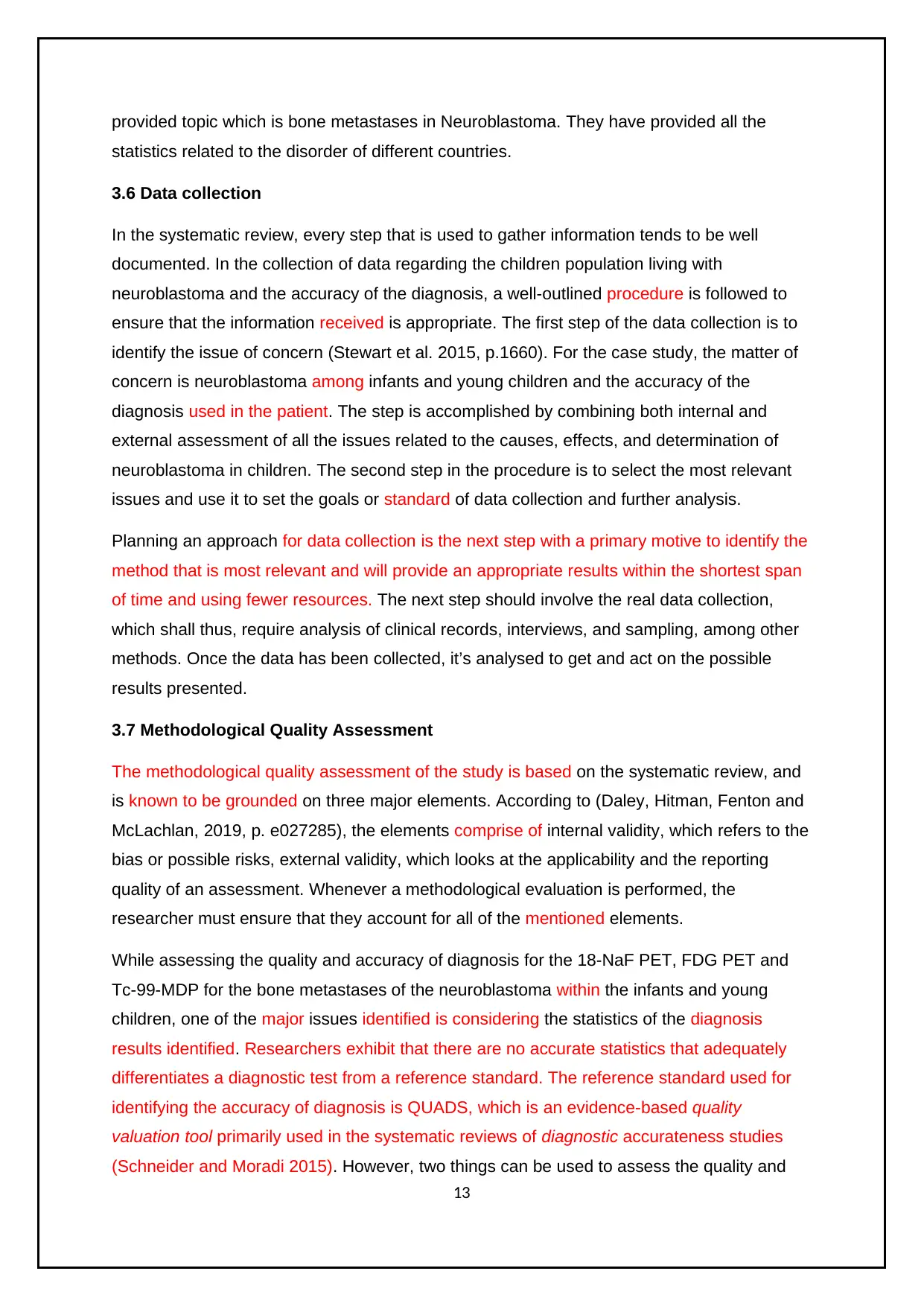
provided topic which is bone metastases in Neuroblastoma. They have provided all the
statistics related to the disorder of different countries.
3.6 Data collection
In the systematic review, every step that is used to gather information tends to be well
documented. In the collection of data regarding the children population living with
neuroblastoma and the accuracy of the diagnosis, a well-outlined procedure is followed to
ensure that the information received is appropriate. The first step of the data collection is to
identify the issue of concern (Stewart et al. 2015, p.1660). For the case study, the matter of
concern is neuroblastoma among infants and young children and the accuracy of the
diagnosis used in the patient. The step is accomplished by combining both internal and
external assessment of all the issues related to the causes, effects, and determination of
neuroblastoma in children. The second step in the procedure is to select the most relevant
issues and use it to set the goals or standard of data collection and further analysis.
Planning an approach for data collection is the next step with a primary motive to identify the
method that is most relevant and will provide an appropriate results within the shortest span
of time and using fewer resources. The next step should involve the real data collection,
which shall thus, require analysis of clinical records, interviews, and sampling, among other
methods. Once the data has been collected, it’s analysed to get and act on the possible
results presented.
3.7 Methodological Quality Assessment
The methodological quality assessment of the study is based on the systematic review, and
is known to be grounded on three major elements. According to (Daley, Hitman, Fenton and
McLachlan, 2019, p. e027285), the elements comprise of internal validity, which refers to the
bias or possible risks, external validity, which looks at the applicability and the reporting
quality of an assessment. Whenever a methodological evaluation is performed, the
researcher must ensure that they account for all of the mentioned elements.
While assessing the quality and accuracy of diagnosis for the 18-NaF PET, FDG PET and
Tc-99-MDP for the bone metastases of the neuroblastoma within the infants and young
children, one of the major issues identified is considering the statistics of the diagnosis
results identified. Researchers exhibit that there are no accurate statistics that adequately
differentiates a diagnostic test from a reference standard. The reference standard used for
identifying the accuracy of diagnosis is QUADS, which is an evidence-based quality
valuation tool primarily used in the systematic reviews of diagnostic accurateness studies
(Schneider and Moradi 2015). However, two things can be used to assess the quality and
13
statistics related to the disorder of different countries.
3.6 Data collection
In the systematic review, every step that is used to gather information tends to be well
documented. In the collection of data regarding the children population living with
neuroblastoma and the accuracy of the diagnosis, a well-outlined procedure is followed to
ensure that the information received is appropriate. The first step of the data collection is to
identify the issue of concern (Stewart et al. 2015, p.1660). For the case study, the matter of
concern is neuroblastoma among infants and young children and the accuracy of the
diagnosis used in the patient. The step is accomplished by combining both internal and
external assessment of all the issues related to the causes, effects, and determination of
neuroblastoma in children. The second step in the procedure is to select the most relevant
issues and use it to set the goals or standard of data collection and further analysis.
Planning an approach for data collection is the next step with a primary motive to identify the
method that is most relevant and will provide an appropriate results within the shortest span
of time and using fewer resources. The next step should involve the real data collection,
which shall thus, require analysis of clinical records, interviews, and sampling, among other
methods. Once the data has been collected, it’s analysed to get and act on the possible
results presented.
3.7 Methodological Quality Assessment
The methodological quality assessment of the study is based on the systematic review, and
is known to be grounded on three major elements. According to (Daley, Hitman, Fenton and
McLachlan, 2019, p. e027285), the elements comprise of internal validity, which refers to the
bias or possible risks, external validity, which looks at the applicability and the reporting
quality of an assessment. Whenever a methodological evaluation is performed, the
researcher must ensure that they account for all of the mentioned elements.
While assessing the quality and accuracy of diagnosis for the 18-NaF PET, FDG PET and
Tc-99-MDP for the bone metastases of the neuroblastoma within the infants and young
children, one of the major issues identified is considering the statistics of the diagnosis
results identified. Researchers exhibit that there are no accurate statistics that adequately
differentiates a diagnostic test from a reference standard. The reference standard used for
identifying the accuracy of diagnosis is QUADS, which is an evidence-based quality
valuation tool primarily used in the systematic reviews of diagnostic accurateness studies
(Schneider and Moradi 2015). However, two things can be used to assess the quality and
13
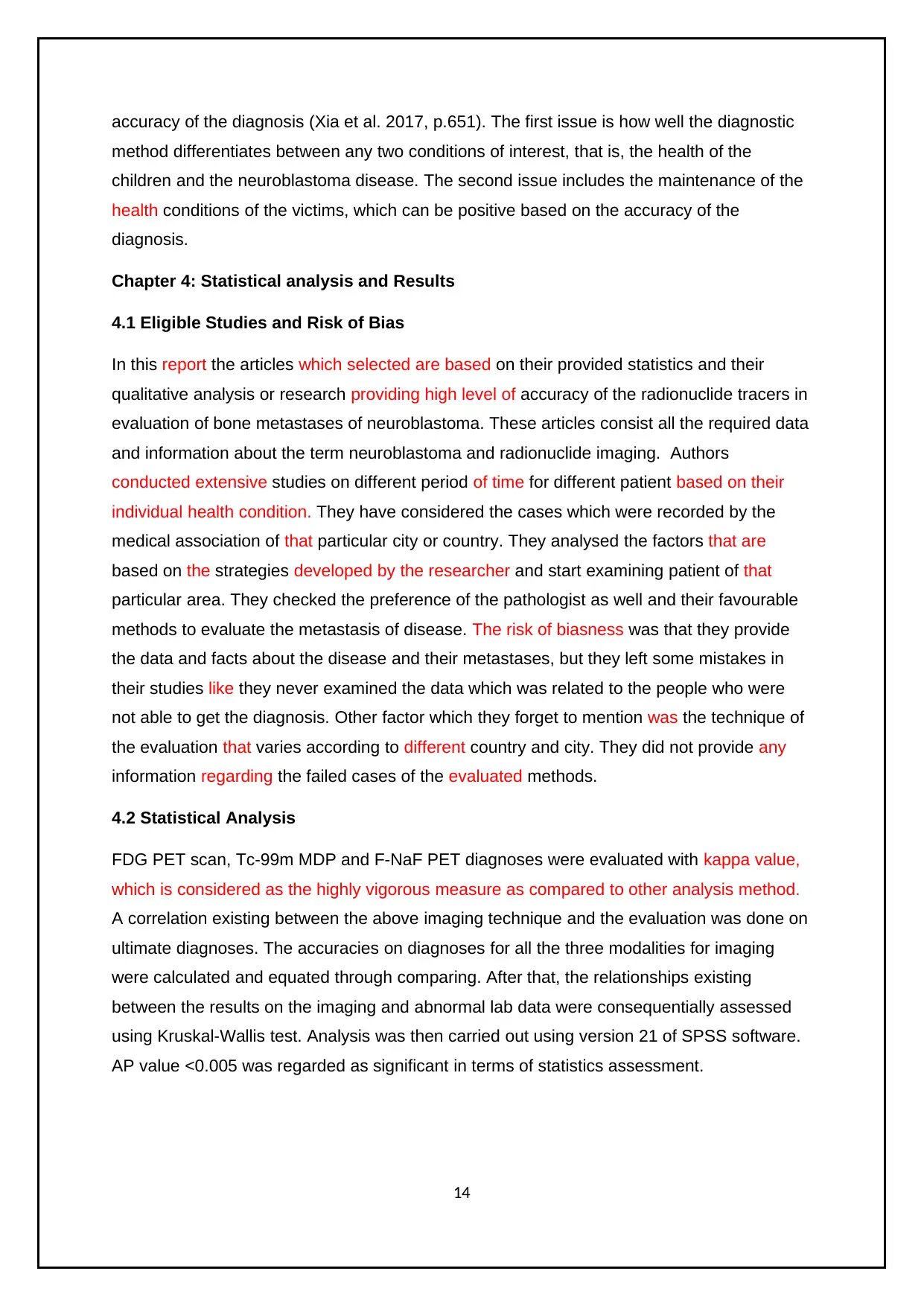
accuracy of the diagnosis (Xia et al. 2017, p.651). The first issue is how well the diagnostic
method differentiates between any two conditions of interest, that is, the health of the
children and the neuroblastoma disease. The second issue includes the maintenance of the
health conditions of the victims, which can be positive based on the accuracy of the
diagnosis.
Chapter 4: Statistical analysis and Results
4.1 Eligible Studies and Risk of Bias
In this report the articles which selected are based on their provided statistics and their
qualitative analysis or research providing high level of accuracy of the radionuclide tracers in
evaluation of bone metastases of neuroblastoma. These articles consist all the required data
and information about the term neuroblastoma and radionuclide imaging. Authors
conducted extensive studies on different period of time for different patient based on their
individual health condition. They have considered the cases which were recorded by the
medical association of that particular city or country. They analysed the factors that are
based on the strategies developed by the researcher and start examining patient of that
particular area. They checked the preference of the pathologist as well and their favourable
methods to evaluate the metastasis of disease. The risk of biasness was that they provide
the data and facts about the disease and their metastases, but they left some mistakes in
their studies like they never examined the data which was related to the people who were
not able to get the diagnosis. Other factor which they forget to mention was the technique of
the evaluation that varies according to different country and city. They did not provide any
information regarding the failed cases of the evaluated methods.
4.2 Statistical Analysis
FDG PET scan, Tc-99m MDP and F-NaF PET diagnoses were evaluated with kappa value,
which is considered as the highly vigorous measure as compared to other analysis method.
A correlation existing between the above imaging technique and the evaluation was done on
ultimate diagnoses. The accuracies on diagnoses for all the three modalities for imaging
were calculated and equated through comparing. After that, the relationships existing
between the results on the imaging and abnormal lab data were consequentially assessed
using Kruskal-Wallis test. Analysis was then carried out using version 21 of SPSS software.
AP value <0.005 was regarded as significant in terms of statistics assessment.
14
method differentiates between any two conditions of interest, that is, the health of the
children and the neuroblastoma disease. The second issue includes the maintenance of the
health conditions of the victims, which can be positive based on the accuracy of the
diagnosis.
Chapter 4: Statistical analysis and Results
4.1 Eligible Studies and Risk of Bias
In this report the articles which selected are based on their provided statistics and their
qualitative analysis or research providing high level of accuracy of the radionuclide tracers in
evaluation of bone metastases of neuroblastoma. These articles consist all the required data
and information about the term neuroblastoma and radionuclide imaging. Authors
conducted extensive studies on different period of time for different patient based on their
individual health condition. They have considered the cases which were recorded by the
medical association of that particular city or country. They analysed the factors that are
based on the strategies developed by the researcher and start examining patient of that
particular area. They checked the preference of the pathologist as well and their favourable
methods to evaluate the metastasis of disease. The risk of biasness was that they provide
the data and facts about the disease and their metastases, but they left some mistakes in
their studies like they never examined the data which was related to the people who were
not able to get the diagnosis. Other factor which they forget to mention was the technique of
the evaluation that varies according to different country and city. They did not provide any
information regarding the failed cases of the evaluated methods.
4.2 Statistical Analysis
FDG PET scan, Tc-99m MDP and F-NaF PET diagnoses were evaluated with kappa value,
which is considered as the highly vigorous measure as compared to other analysis method.
A correlation existing between the above imaging technique and the evaluation was done on
ultimate diagnoses. The accuracies on diagnoses for all the three modalities for imaging
were calculated and equated through comparing. After that, the relationships existing
between the results on the imaging and abnormal lab data were consequentially assessed
using Kruskal-Wallis test. Analysis was then carried out using version 21 of SPSS software.
AP value <0.005 was regarded as significant in terms of statistics assessment.
14
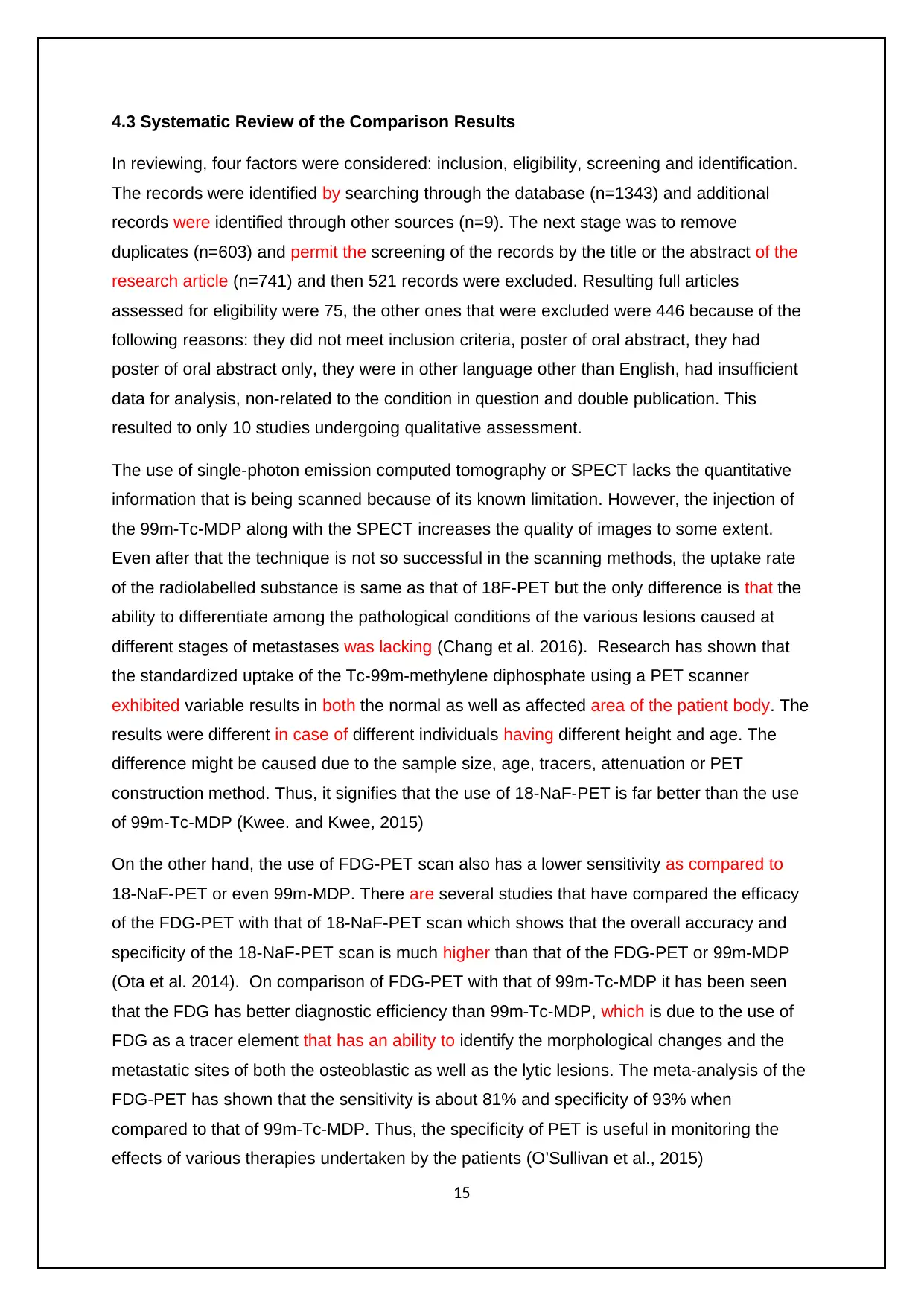
4.3 Systematic Review of the Comparison Results
In reviewing, four factors were considered: inclusion, eligibility, screening and identification.
The records were identified by searching through the database (n=1343) and additional
records were identified through other sources (n=9). The next stage was to remove
duplicates (n=603) and permit the screening of the records by the title or the abstract of the
research article (n=741) and then 521 records were excluded. Resulting full articles
assessed for eligibility were 75, the other ones that were excluded were 446 because of the
following reasons: they did not meet inclusion criteria, poster of oral abstract, they had
poster of oral abstract only, they were in other language other than English, had insufficient
data for analysis, non-related to the condition in question and double publication. This
resulted to only 10 studies undergoing qualitative assessment.
The use of single-photon emission computed tomography or SPECT lacks the quantitative
information that is being scanned because of its known limitation. However, the injection of
the 99m-Tc-MDP along with the SPECT increases the quality of images to some extent.
Even after that the technique is not so successful in the scanning methods, the uptake rate
of the radiolabelled substance is same as that of 18F-PET but the only difference is that the
ability to differentiate among the pathological conditions of the various lesions caused at
different stages of metastases was lacking (Chang et al. 2016). Research has shown that
the standardized uptake of the Tc-99m-methylene diphosphate using a PET scanner
exhibited variable results in both the normal as well as affected area of the patient body. The
results were different in case of different individuals having different height and age. The
difference might be caused due to the sample size, age, tracers, attenuation or PET
construction method. Thus, it signifies that the use of 18-NaF-PET is far better than the use
of 99m-Tc-MDP (Kwee. and Kwee, 2015)
On the other hand, the use of FDG-PET scan also has a lower sensitivity as compared to
18-NaF-PET or even 99m-MDP. There are several studies that have compared the efficacy
of the FDG-PET with that of 18-NaF-PET scan which shows that the overall accuracy and
specificity of the 18-NaF-PET scan is much higher than that of the FDG-PET or 99m-MDP
(Ota et al. 2014). On comparison of FDG-PET with that of 99m-Tc-MDP it has been seen
that the FDG has better diagnostic efficiency than 99m-Tc-MDP, which is due to the use of
FDG as a tracer element that has an ability to identify the morphological changes and the
metastatic sites of both the osteoblastic as well as the lytic lesions. The meta-analysis of the
FDG-PET has shown that the sensitivity is about 81% and specificity of 93% when
compared to that of 99m-Tc-MDP. Thus, the specificity of PET is useful in monitoring the
effects of various therapies undertaken by the patients (O’Sullivan et al., 2015)
15
In reviewing, four factors were considered: inclusion, eligibility, screening and identification.
The records were identified by searching through the database (n=1343) and additional
records were identified through other sources (n=9). The next stage was to remove
duplicates (n=603) and permit the screening of the records by the title or the abstract of the
research article (n=741) and then 521 records were excluded. Resulting full articles
assessed for eligibility were 75, the other ones that were excluded were 446 because of the
following reasons: they did not meet inclusion criteria, poster of oral abstract, they had
poster of oral abstract only, they were in other language other than English, had insufficient
data for analysis, non-related to the condition in question and double publication. This
resulted to only 10 studies undergoing qualitative assessment.
The use of single-photon emission computed tomography or SPECT lacks the quantitative
information that is being scanned because of its known limitation. However, the injection of
the 99m-Tc-MDP along with the SPECT increases the quality of images to some extent.
Even after that the technique is not so successful in the scanning methods, the uptake rate
of the radiolabelled substance is same as that of 18F-PET but the only difference is that the
ability to differentiate among the pathological conditions of the various lesions caused at
different stages of metastases was lacking (Chang et al. 2016). Research has shown that
the standardized uptake of the Tc-99m-methylene diphosphate using a PET scanner
exhibited variable results in both the normal as well as affected area of the patient body. The
results were different in case of different individuals having different height and age. The
difference might be caused due to the sample size, age, tracers, attenuation or PET
construction method. Thus, it signifies that the use of 18-NaF-PET is far better than the use
of 99m-Tc-MDP (Kwee. and Kwee, 2015)
On the other hand, the use of FDG-PET scan also has a lower sensitivity as compared to
18-NaF-PET or even 99m-MDP. There are several studies that have compared the efficacy
of the FDG-PET with that of 18-NaF-PET scan which shows that the overall accuracy and
specificity of the 18-NaF-PET scan is much higher than that of the FDG-PET or 99m-MDP
(Ota et al. 2014). On comparison of FDG-PET with that of 99m-Tc-MDP it has been seen
that the FDG has better diagnostic efficiency than 99m-Tc-MDP, which is due to the use of
FDG as a tracer element that has an ability to identify the morphological changes and the
metastatic sites of both the osteoblastic as well as the lytic lesions. The meta-analysis of the
FDG-PET has shown that the sensitivity is about 81% and specificity of 93% when
compared to that of 99m-Tc-MDP. Thus, the specificity of PET is useful in monitoring the
effects of various therapies undertaken by the patients (O’Sullivan et al., 2015)
15
Secure Best Marks with AI Grader
Need help grading? Try our AI Grader for instant feedback on your assignments.
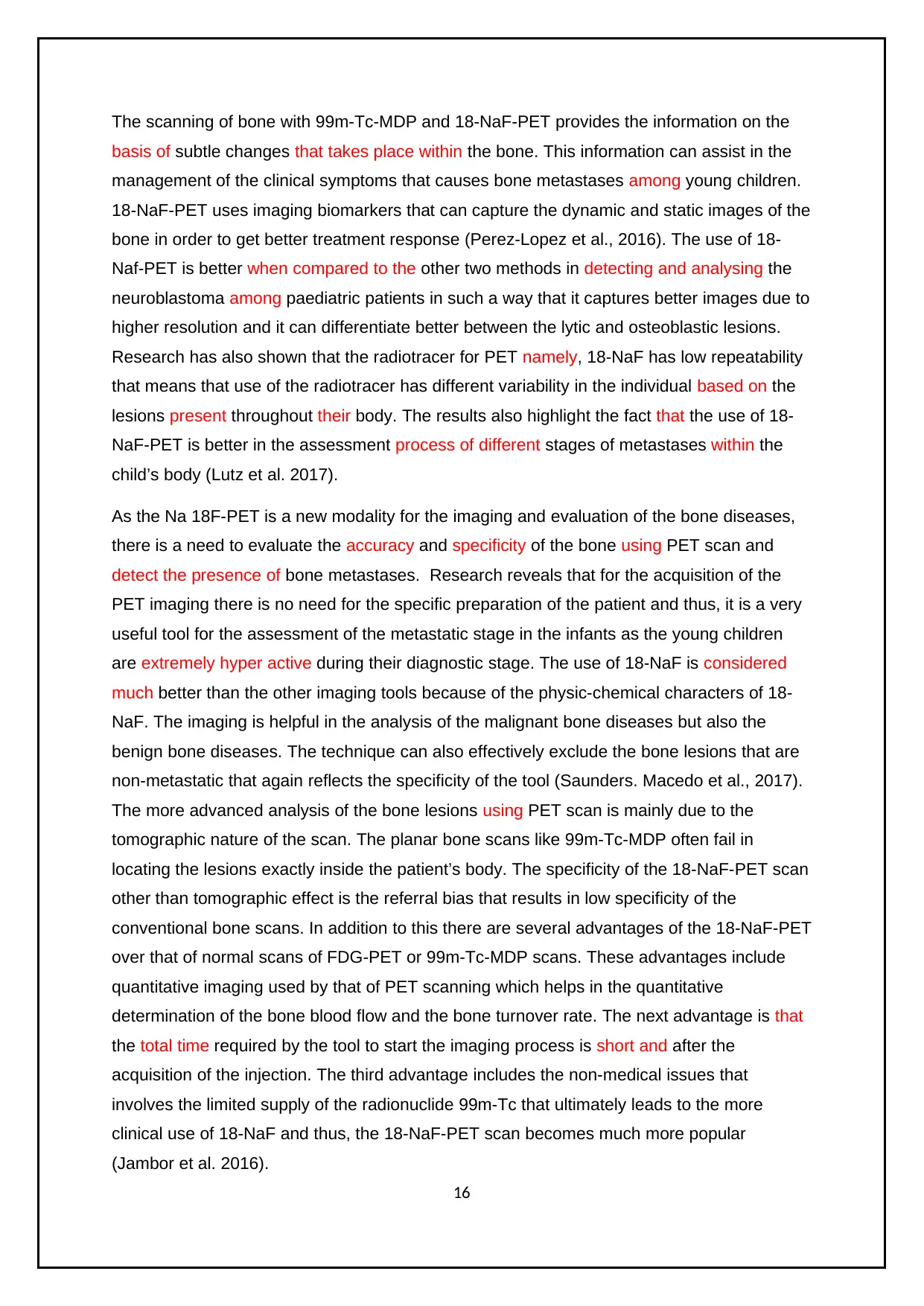
The scanning of bone with 99m-Tc-MDP and 18-NaF-PET provides the information on the
basis of subtle changes that takes place within the bone. This information can assist in the
management of the clinical symptoms that causes bone metastases among young children.
18-NaF-PET uses imaging biomarkers that can capture the dynamic and static images of the
bone in order to get better treatment response (Perez-Lopez et al., 2016). The use of 18-
Naf-PET is better when compared to the other two methods in detecting and analysing the
neuroblastoma among paediatric patients in such a way that it captures better images due to
higher resolution and it can differentiate better between the lytic and osteoblastic lesions.
Research has also shown that the radiotracer for PET namely, 18-NaF has low repeatability
that means that use of the radiotracer has different variability in the individual based on the
lesions present throughout their body. The results also highlight the fact that the use of 18-
NaF-PET is better in the assessment process of different stages of metastases within the
child’s body (Lutz et al. 2017).
As the Na 18F-PET is a new modality for the imaging and evaluation of the bone diseases,
there is a need to evaluate the accuracy and specificity of the bone using PET scan and
detect the presence of bone metastases. Research reveals that for the acquisition of the
PET imaging there is no need for the specific preparation of the patient and thus, it is a very
useful tool for the assessment of the metastatic stage in the infants as the young children
are extremely hyper active during their diagnostic stage. The use of 18-NaF is considered
much better than the other imaging tools because of the physic-chemical characters of 18-
NaF. The imaging is helpful in the analysis of the malignant bone diseases but also the
benign bone diseases. The technique can also effectively exclude the bone lesions that are
non-metastatic that again reflects the specificity of the tool (Saunders. Macedo et al., 2017).
The more advanced analysis of the bone lesions using PET scan is mainly due to the
tomographic nature of the scan. The planar bone scans like 99m-Tc-MDP often fail in
locating the lesions exactly inside the patient’s body. The specificity of the 18-NaF-PET scan
other than tomographic effect is the referral bias that results in low specificity of the
conventional bone scans. In addition to this there are several advantages of the 18-NaF-PET
over that of normal scans of FDG-PET or 99m-Tc-MDP scans. These advantages include
quantitative imaging used by that of PET scanning which helps in the quantitative
determination of the bone blood flow and the bone turnover rate. The next advantage is that
the total time required by the tool to start the imaging process is short and after the
acquisition of the injection. The third advantage includes the non-medical issues that
involves the limited supply of the radionuclide 99m-Tc that ultimately leads to the more
clinical use of 18-NaF and thus, the 18-NaF-PET scan becomes much more popular
(Jambor et al. 2016).
16
basis of subtle changes that takes place within the bone. This information can assist in the
management of the clinical symptoms that causes bone metastases among young children.
18-NaF-PET uses imaging biomarkers that can capture the dynamic and static images of the
bone in order to get better treatment response (Perez-Lopez et al., 2016). The use of 18-
Naf-PET is better when compared to the other two methods in detecting and analysing the
neuroblastoma among paediatric patients in such a way that it captures better images due to
higher resolution and it can differentiate better between the lytic and osteoblastic lesions.
Research has also shown that the radiotracer for PET namely, 18-NaF has low repeatability
that means that use of the radiotracer has different variability in the individual based on the
lesions present throughout their body. The results also highlight the fact that the use of 18-
NaF-PET is better in the assessment process of different stages of metastases within the
child’s body (Lutz et al. 2017).
As the Na 18F-PET is a new modality for the imaging and evaluation of the bone diseases,
there is a need to evaluate the accuracy and specificity of the bone using PET scan and
detect the presence of bone metastases. Research reveals that for the acquisition of the
PET imaging there is no need for the specific preparation of the patient and thus, it is a very
useful tool for the assessment of the metastatic stage in the infants as the young children
are extremely hyper active during their diagnostic stage. The use of 18-NaF is considered
much better than the other imaging tools because of the physic-chemical characters of 18-
NaF. The imaging is helpful in the analysis of the malignant bone diseases but also the
benign bone diseases. The technique can also effectively exclude the bone lesions that are
non-metastatic that again reflects the specificity of the tool (Saunders. Macedo et al., 2017).
The more advanced analysis of the bone lesions using PET scan is mainly due to the
tomographic nature of the scan. The planar bone scans like 99m-Tc-MDP often fail in
locating the lesions exactly inside the patient’s body. The specificity of the 18-NaF-PET scan
other than tomographic effect is the referral bias that results in low specificity of the
conventional bone scans. In addition to this there are several advantages of the 18-NaF-PET
over that of normal scans of FDG-PET or 99m-Tc-MDP scans. These advantages include
quantitative imaging used by that of PET scanning which helps in the quantitative
determination of the bone blood flow and the bone turnover rate. The next advantage is that
the total time required by the tool to start the imaging process is short and after the
acquisition of the injection. The third advantage includes the non-medical issues that
involves the limited supply of the radionuclide 99m-Tc that ultimately leads to the more
clinical use of 18-NaF and thus, the 18-NaF-PET scan becomes much more popular
(Jambor et al. 2016).
16
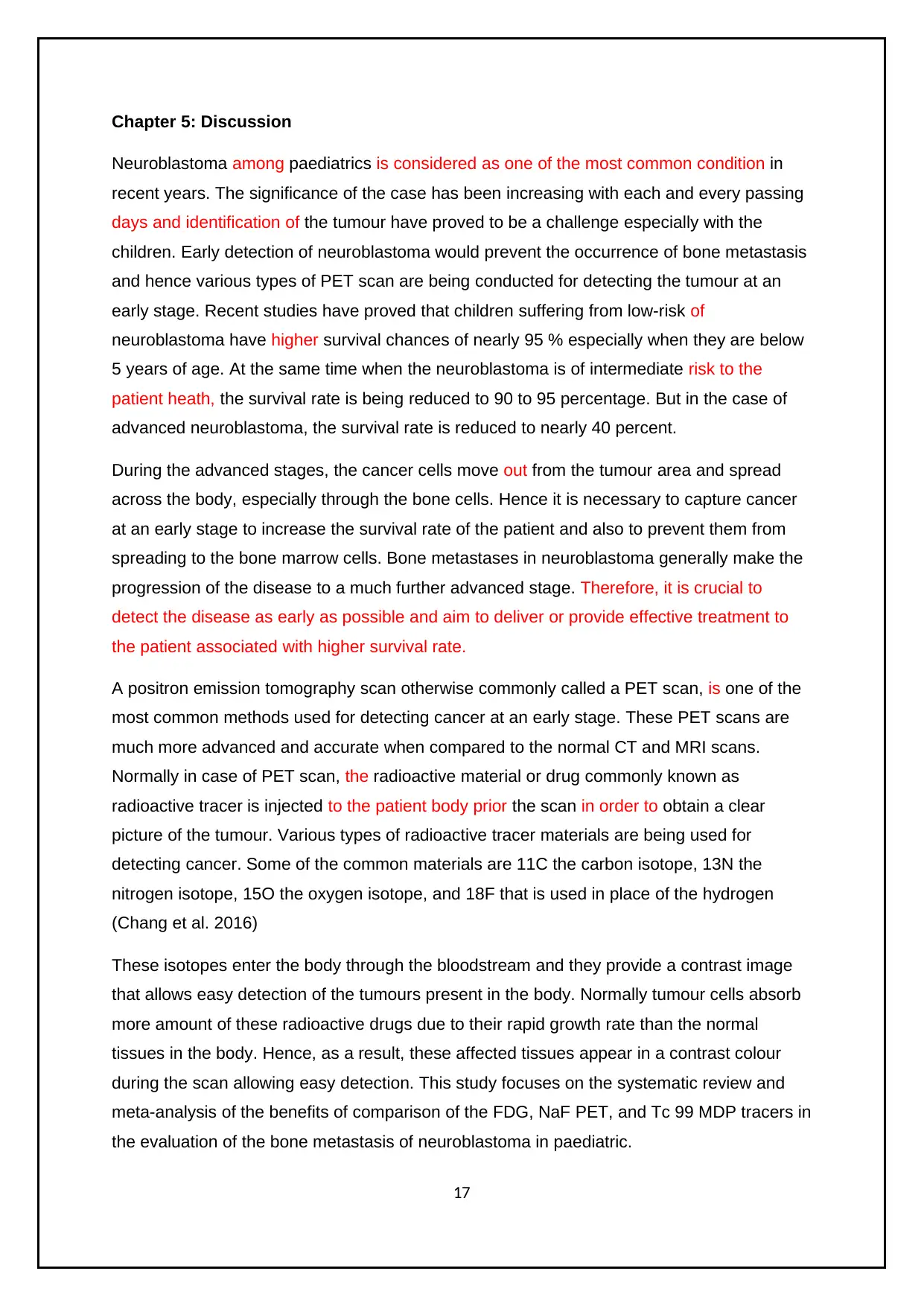
Chapter 5: Discussion
Neuroblastoma among paediatrics is considered as one of the most common condition in
recent years. The significance of the case has been increasing with each and every passing
days and identification of the tumour have proved to be a challenge especially with the
children. Early detection of neuroblastoma would prevent the occurrence of bone metastasis
and hence various types of PET scan are being conducted for detecting the tumour at an
early stage. Recent studies have proved that children suffering from low-risk of
neuroblastoma have higher survival chances of nearly 95 % especially when they are below
5 years of age. At the same time when the neuroblastoma is of intermediate risk to the
patient heath, the survival rate is being reduced to 90 to 95 percentage. But in the case of
advanced neuroblastoma, the survival rate is reduced to nearly 40 percent.
During the advanced stages, the cancer cells move out from the tumour area and spread
across the body, especially through the bone cells. Hence it is necessary to capture cancer
at an early stage to increase the survival rate of the patient and also to prevent them from
spreading to the bone marrow cells. Bone metastases in neuroblastoma generally make the
progression of the disease to a much further advanced stage. Therefore, it is crucial to
detect the disease as early as possible and aim to deliver or provide effective treatment to
the patient associated with higher survival rate.
A positron emission tomography scan otherwise commonly called a PET scan, is one of the
most common methods used for detecting cancer at an early stage. These PET scans are
much more advanced and accurate when compared to the normal CT and MRI scans.
Normally in case of PET scan, the radioactive material or drug commonly known as
radioactive tracer is injected to the patient body prior the scan in order to obtain a clear
picture of the tumour. Various types of radioactive tracer materials are being used for
detecting cancer. Some of the common materials are 11C the carbon isotope, 13N the
nitrogen isotope, 15O the oxygen isotope, and 18F that is used in place of the hydrogen
(Chang et al. 2016)
These isotopes enter the body through the bloodstream and they provide a contrast image
that allows easy detection of the tumours present in the body. Normally tumour cells absorb
more amount of these radioactive drugs due to their rapid growth rate than the normal
tissues in the body. Hence, as a result, these affected tissues appear in a contrast colour
during the scan allowing easy detection. This study focuses on the systematic review and
meta-analysis of the benefits of comparison of the FDG, NaF PET, and Tc 99 MDP tracers in
the evaluation of the bone metastasis of neuroblastoma in paediatric.
17
Neuroblastoma among paediatrics is considered as one of the most common condition in
recent years. The significance of the case has been increasing with each and every passing
days and identification of the tumour have proved to be a challenge especially with the
children. Early detection of neuroblastoma would prevent the occurrence of bone metastasis
and hence various types of PET scan are being conducted for detecting the tumour at an
early stage. Recent studies have proved that children suffering from low-risk of
neuroblastoma have higher survival chances of nearly 95 % especially when they are below
5 years of age. At the same time when the neuroblastoma is of intermediate risk to the
patient heath, the survival rate is being reduced to 90 to 95 percentage. But in the case of
advanced neuroblastoma, the survival rate is reduced to nearly 40 percent.
During the advanced stages, the cancer cells move out from the tumour area and spread
across the body, especially through the bone cells. Hence it is necessary to capture cancer
at an early stage to increase the survival rate of the patient and also to prevent them from
spreading to the bone marrow cells. Bone metastases in neuroblastoma generally make the
progression of the disease to a much further advanced stage. Therefore, it is crucial to
detect the disease as early as possible and aim to deliver or provide effective treatment to
the patient associated with higher survival rate.
A positron emission tomography scan otherwise commonly called a PET scan, is one of the
most common methods used for detecting cancer at an early stage. These PET scans are
much more advanced and accurate when compared to the normal CT and MRI scans.
Normally in case of PET scan, the radioactive material or drug commonly known as
radioactive tracer is injected to the patient body prior the scan in order to obtain a clear
picture of the tumour. Various types of radioactive tracer materials are being used for
detecting cancer. Some of the common materials are 11C the carbon isotope, 13N the
nitrogen isotope, 15O the oxygen isotope, and 18F that is used in place of the hydrogen
(Chang et al. 2016)
These isotopes enter the body through the bloodstream and they provide a contrast image
that allows easy detection of the tumours present in the body. Normally tumour cells absorb
more amount of these radioactive drugs due to their rapid growth rate than the normal
tissues in the body. Hence, as a result, these affected tissues appear in a contrast colour
during the scan allowing easy detection. This study focuses on the systematic review and
meta-analysis of the benefits of comparison of the FDG, NaF PET, and Tc 99 MDP tracers in
the evaluation of the bone metastasis of neuroblastoma in paediatric.
17
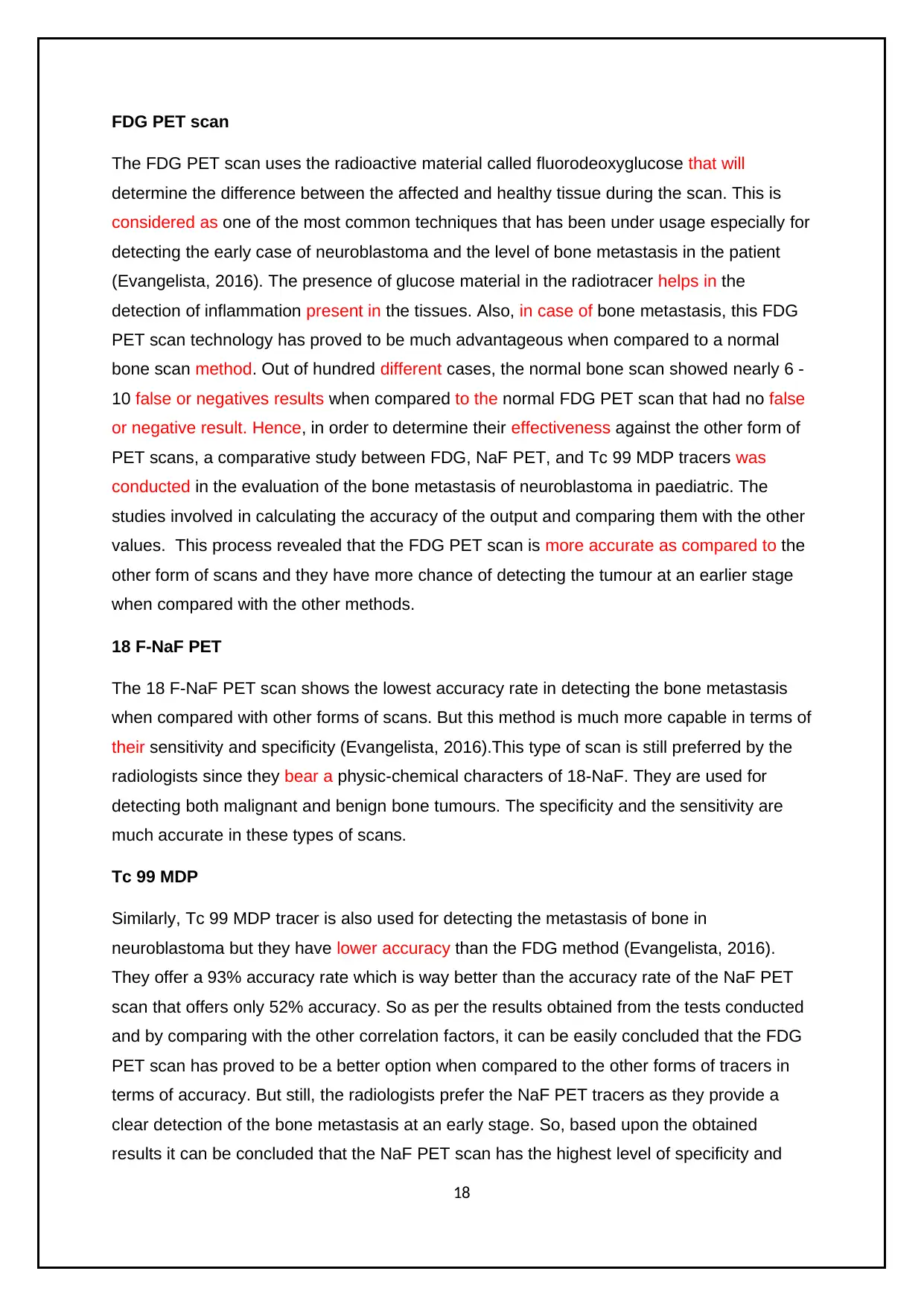
FDG PET scan
The FDG PET scan uses the radioactive material called fluorodeoxyglucose that will
determine the difference between the affected and healthy tissue during the scan. This is
considered as one of the most common techniques that has been under usage especially for
detecting the early case of neuroblastoma and the level of bone metastasis in the patient
(Evangelista, 2016). The presence of glucose material in the radiotracer helps in the
detection of inflammation present in the tissues. Also, in case of bone metastasis, this FDG
PET scan technology has proved to be much advantageous when compared to a normal
bone scan method. Out of hundred different cases, the normal bone scan showed nearly 6 -
10 false or negatives results when compared to the normal FDG PET scan that had no false
or negative result. Hence, in order to determine their effectiveness against the other form of
PET scans, a comparative study between FDG, NaF PET, and Tc 99 MDP tracers was
conducted in the evaluation of the bone metastasis of neuroblastoma in paediatric. The
studies involved in calculating the accuracy of the output and comparing them with the other
values. This process revealed that the FDG PET scan is more accurate as compared to the
other form of scans and they have more chance of detecting the tumour at an earlier stage
when compared with the other methods.
18 F-NaF PET
The 18 F-NaF PET scan shows the lowest accuracy rate in detecting the bone metastasis
when compared with other forms of scans. But this method is much more capable in terms of
their sensitivity and specificity (Evangelista, 2016).This type of scan is still preferred by the
radiologists since they bear a physic-chemical characters of 18-NaF. They are used for
detecting both malignant and benign bone tumours. The specificity and the sensitivity are
much accurate in these types of scans.
Tc 99 MDP
Similarly, Tc 99 MDP tracer is also used for detecting the metastasis of bone in
neuroblastoma but they have lower accuracy than the FDG method (Evangelista, 2016).
They offer a 93% accuracy rate which is way better than the accuracy rate of the NaF PET
scan that offers only 52% accuracy. So as per the results obtained from the tests conducted
and by comparing with the other correlation factors, it can be easily concluded that the FDG
PET scan has proved to be a better option when compared to the other forms of tracers in
terms of accuracy. But still, the radiologists prefer the NaF PET tracers as they provide a
clear detection of the bone metastasis at an early stage. So, based upon the obtained
results it can be concluded that the NaF PET scan has the highest level of specificity and
18
The FDG PET scan uses the radioactive material called fluorodeoxyglucose that will
determine the difference between the affected and healthy tissue during the scan. This is
considered as one of the most common techniques that has been under usage especially for
detecting the early case of neuroblastoma and the level of bone metastasis in the patient
(Evangelista, 2016). The presence of glucose material in the radiotracer helps in the
detection of inflammation present in the tissues. Also, in case of bone metastasis, this FDG
PET scan technology has proved to be much advantageous when compared to a normal
bone scan method. Out of hundred different cases, the normal bone scan showed nearly 6 -
10 false or negatives results when compared to the normal FDG PET scan that had no false
or negative result. Hence, in order to determine their effectiveness against the other form of
PET scans, a comparative study between FDG, NaF PET, and Tc 99 MDP tracers was
conducted in the evaluation of the bone metastasis of neuroblastoma in paediatric. The
studies involved in calculating the accuracy of the output and comparing them with the other
values. This process revealed that the FDG PET scan is more accurate as compared to the
other form of scans and they have more chance of detecting the tumour at an earlier stage
when compared with the other methods.
18 F-NaF PET
The 18 F-NaF PET scan shows the lowest accuracy rate in detecting the bone metastasis
when compared with other forms of scans. But this method is much more capable in terms of
their sensitivity and specificity (Evangelista, 2016).This type of scan is still preferred by the
radiologists since they bear a physic-chemical characters of 18-NaF. They are used for
detecting both malignant and benign bone tumours. The specificity and the sensitivity are
much accurate in these types of scans.
Tc 99 MDP
Similarly, Tc 99 MDP tracer is also used for detecting the metastasis of bone in
neuroblastoma but they have lower accuracy than the FDG method (Evangelista, 2016).
They offer a 93% accuracy rate which is way better than the accuracy rate of the NaF PET
scan that offers only 52% accuracy. So as per the results obtained from the tests conducted
and by comparing with the other correlation factors, it can be easily concluded that the FDG
PET scan has proved to be a better option when compared to the other forms of tracers in
terms of accuracy. But still, the radiologists prefer the NaF PET tracers as they provide a
clear detection of the bone metastasis at an early stage. So, based upon the obtained
results it can be concluded that the NaF PET scan has the highest level of specificity and
18
Paraphrase This Document
Need a fresh take? Get an instant paraphrase of this document with our AI Paraphraser
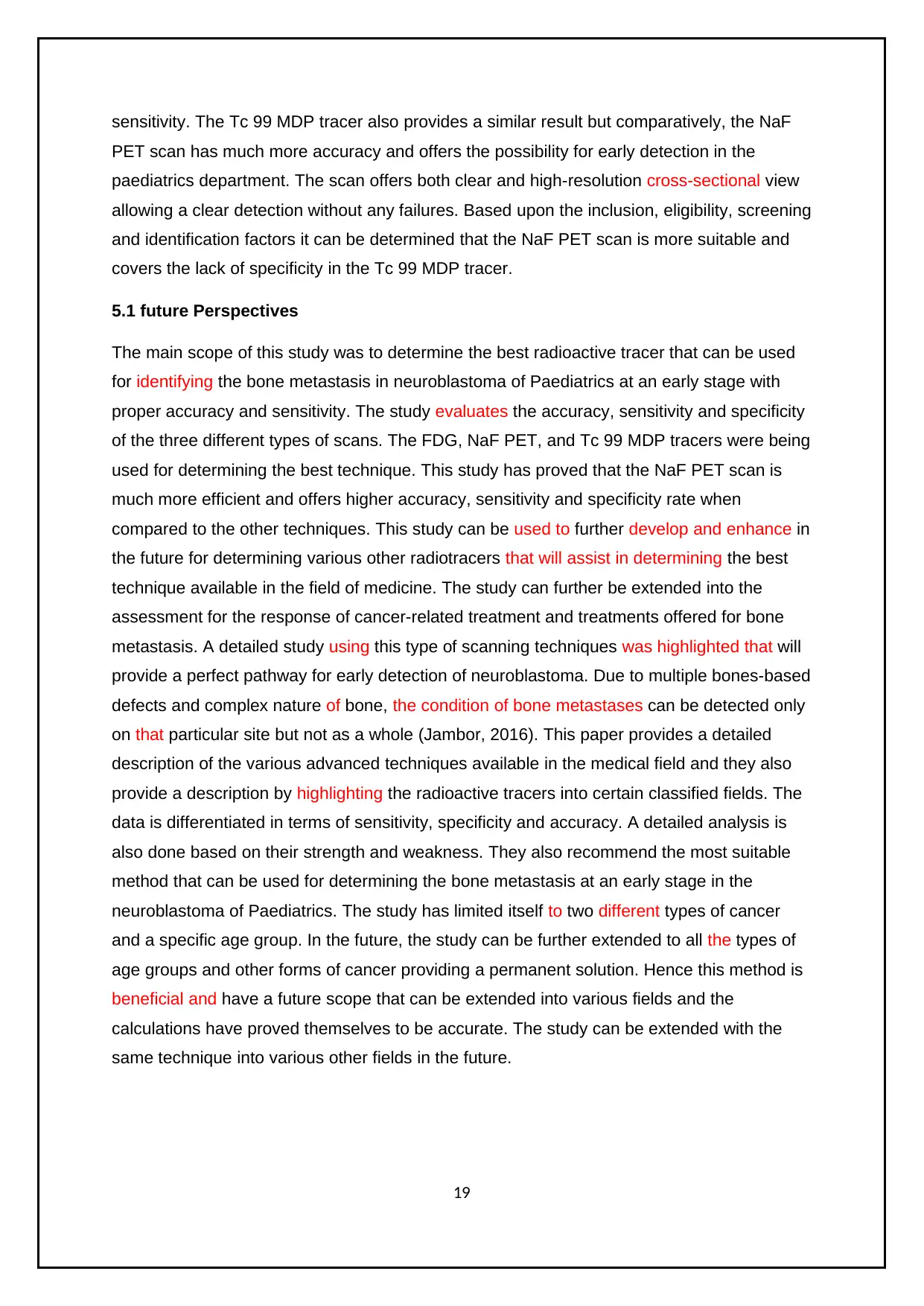
sensitivity. The Tc 99 MDP tracer also provides a similar result but comparatively, the NaF
PET scan has much more accuracy and offers the possibility for early detection in the
paediatrics department. The scan offers both clear and high-resolution cross-sectional view
allowing a clear detection without any failures. Based upon the inclusion, eligibility, screening
and identification factors it can be determined that the NaF PET scan is more suitable and
covers the lack of specificity in the Tc 99 MDP tracer.
5.1 future Perspectives
The main scope of this study was to determine the best radioactive tracer that can be used
for identifying the bone metastasis in neuroblastoma of Paediatrics at an early stage with
proper accuracy and sensitivity. The study evaluates the accuracy, sensitivity and specificity
of the three different types of scans. The FDG, NaF PET, and Tc 99 MDP tracers were being
used for determining the best technique. This study has proved that the NaF PET scan is
much more efficient and offers higher accuracy, sensitivity and specificity rate when
compared to the other techniques. This study can be used to further develop and enhance in
the future for determining various other radiotracers that will assist in determining the best
technique available in the field of medicine. The study can further be extended into the
assessment for the response of cancer-related treatment and treatments offered for bone
metastasis. A detailed study using this type of scanning techniques was highlighted that will
provide a perfect pathway for early detection of neuroblastoma. Due to multiple bones-based
defects and complex nature of bone, the condition of bone metastases can be detected only
on that particular site but not as a whole (Jambor, 2016). This paper provides a detailed
description of the various advanced techniques available in the medical field and they also
provide a description by highlighting the radioactive tracers into certain classified fields. The
data is differentiated in terms of sensitivity, specificity and accuracy. A detailed analysis is
also done based on their strength and weakness. They also recommend the most suitable
method that can be used for determining the bone metastasis at an early stage in the
neuroblastoma of Paediatrics. The study has limited itself to two different types of cancer
and a specific age group. In the future, the study can be further extended to all the types of
age groups and other forms of cancer providing a permanent solution. Hence this method is
beneficial and have a future scope that can be extended into various fields and the
calculations have proved themselves to be accurate. The study can be extended with the
same technique into various other fields in the future.
19
PET scan has much more accuracy and offers the possibility for early detection in the
paediatrics department. The scan offers both clear and high-resolution cross-sectional view
allowing a clear detection without any failures. Based upon the inclusion, eligibility, screening
and identification factors it can be determined that the NaF PET scan is more suitable and
covers the lack of specificity in the Tc 99 MDP tracer.
5.1 future Perspectives
The main scope of this study was to determine the best radioactive tracer that can be used
for identifying the bone metastasis in neuroblastoma of Paediatrics at an early stage with
proper accuracy and sensitivity. The study evaluates the accuracy, sensitivity and specificity
of the three different types of scans. The FDG, NaF PET, and Tc 99 MDP tracers were being
used for determining the best technique. This study has proved that the NaF PET scan is
much more efficient and offers higher accuracy, sensitivity and specificity rate when
compared to the other techniques. This study can be used to further develop and enhance in
the future for determining various other radiotracers that will assist in determining the best
technique available in the field of medicine. The study can further be extended into the
assessment for the response of cancer-related treatment and treatments offered for bone
metastasis. A detailed study using this type of scanning techniques was highlighted that will
provide a perfect pathway for early detection of neuroblastoma. Due to multiple bones-based
defects and complex nature of bone, the condition of bone metastases can be detected only
on that particular site but not as a whole (Jambor, 2016). This paper provides a detailed
description of the various advanced techniques available in the medical field and they also
provide a description by highlighting the radioactive tracers into certain classified fields. The
data is differentiated in terms of sensitivity, specificity and accuracy. A detailed analysis is
also done based on their strength and weakness. They also recommend the most suitable
method that can be used for determining the bone metastasis at an early stage in the
neuroblastoma of Paediatrics. The study has limited itself to two different types of cancer
and a specific age group. In the future, the study can be further extended to all the types of
age groups and other forms of cancer providing a permanent solution. Hence this method is
beneficial and have a future scope that can be extended into various fields and the
calculations have proved themselves to be accurate. The study can be extended with the
same technique into various other fields in the future.
19
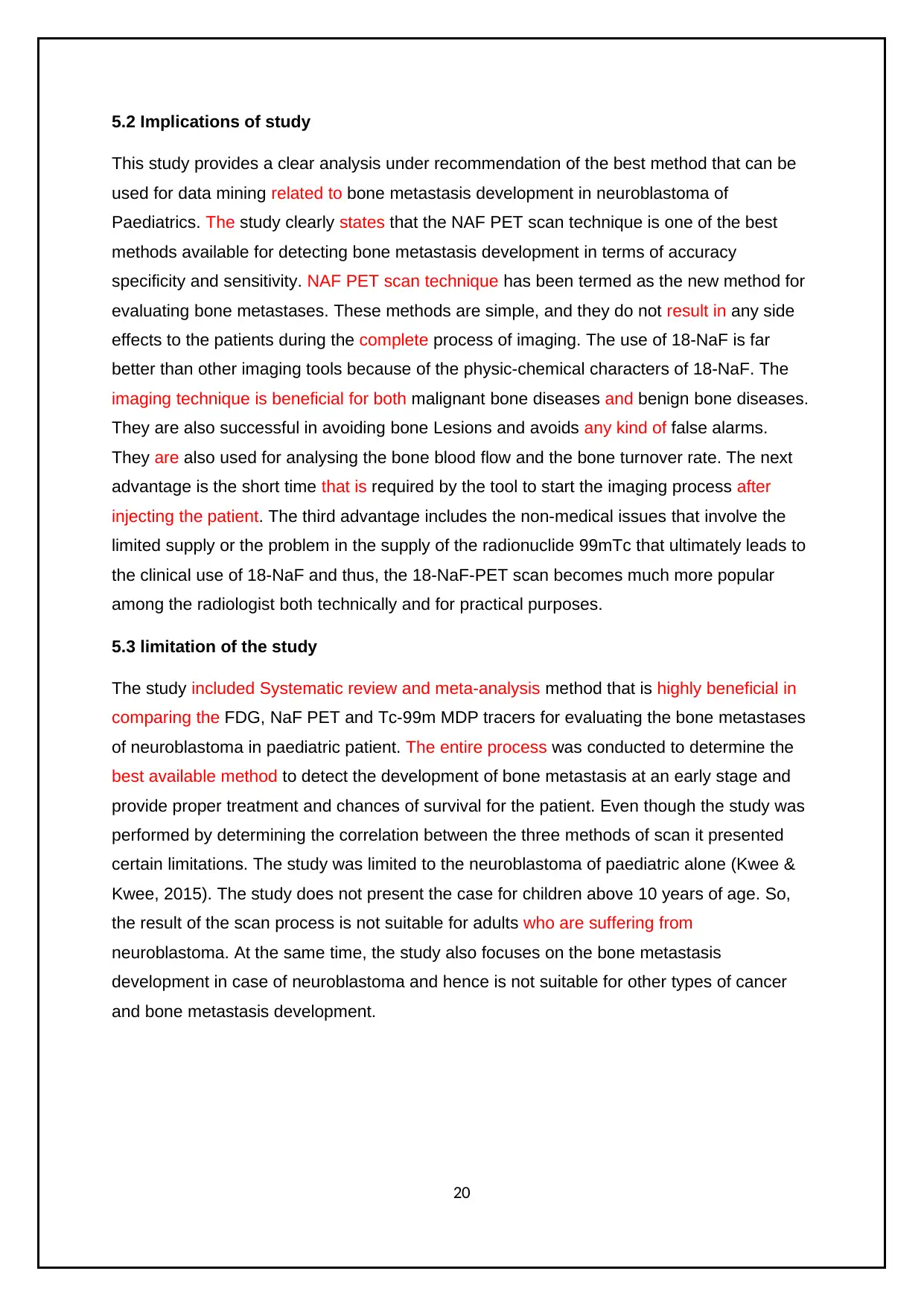
5.2 Implications of study
This study provides a clear analysis under recommendation of the best method that can be
used for data mining related to bone metastasis development in neuroblastoma of
Paediatrics. The study clearly states that the NAF PET scan technique is one of the best
methods available for detecting bone metastasis development in terms of accuracy
specificity and sensitivity. NAF PET scan technique has been termed as the new method for
evaluating bone metastases. These methods are simple, and they do not result in any side
effects to the patients during the complete process of imaging. The use of 18-NaF is far
better than other imaging tools because of the physic-chemical characters of 18-NaF. The
imaging technique is beneficial for both malignant bone diseases and benign bone diseases.
They are also successful in avoiding bone Lesions and avoids any kind of false alarms.
They are also used for analysing the bone blood flow and the bone turnover rate. The next
advantage is the short time that is required by the tool to start the imaging process after
injecting the patient. The third advantage includes the non-medical issues that involve the
limited supply or the problem in the supply of the radionuclide 99mTc that ultimately leads to
the clinical use of 18-NaF and thus, the 18-NaF-PET scan becomes much more popular
among the radiologist both technically and for practical purposes.
5.3 limitation of the study
The study included Systematic review and meta-analysis method that is highly beneficial in
comparing the FDG, NaF PET and Tc-99m MDP tracers for evaluating the bone metastases
of neuroblastoma in paediatric patient. The entire process was conducted to determine the
best available method to detect the development of bone metastasis at an early stage and
provide proper treatment and chances of survival for the patient. Even though the study was
performed by determining the correlation between the three methods of scan it presented
certain limitations. The study was limited to the neuroblastoma of paediatric alone (Kwee &
Kwee, 2015). The study does not present the case for children above 10 years of age. So,
the result of the scan process is not suitable for adults who are suffering from
neuroblastoma. At the same time, the study also focuses on the bone metastasis
development in case of neuroblastoma and hence is not suitable for other types of cancer
and bone metastasis development.
20
This study provides a clear analysis under recommendation of the best method that can be
used for data mining related to bone metastasis development in neuroblastoma of
Paediatrics. The study clearly states that the NAF PET scan technique is one of the best
methods available for detecting bone metastasis development in terms of accuracy
specificity and sensitivity. NAF PET scan technique has been termed as the new method for
evaluating bone metastases. These methods are simple, and they do not result in any side
effects to the patients during the complete process of imaging. The use of 18-NaF is far
better than other imaging tools because of the physic-chemical characters of 18-NaF. The
imaging technique is beneficial for both malignant bone diseases and benign bone diseases.
They are also successful in avoiding bone Lesions and avoids any kind of false alarms.
They are also used for analysing the bone blood flow and the bone turnover rate. The next
advantage is the short time that is required by the tool to start the imaging process after
injecting the patient. The third advantage includes the non-medical issues that involve the
limited supply or the problem in the supply of the radionuclide 99mTc that ultimately leads to
the clinical use of 18-NaF and thus, the 18-NaF-PET scan becomes much more popular
among the radiologist both technically and for practical purposes.
5.3 limitation of the study
The study included Systematic review and meta-analysis method that is highly beneficial in
comparing the FDG, NaF PET and Tc-99m MDP tracers for evaluating the bone metastases
of neuroblastoma in paediatric patient. The entire process was conducted to determine the
best available method to detect the development of bone metastasis at an early stage and
provide proper treatment and chances of survival for the patient. Even though the study was
performed by determining the correlation between the three methods of scan it presented
certain limitations. The study was limited to the neuroblastoma of paediatric alone (Kwee &
Kwee, 2015). The study does not present the case for children above 10 years of age. So,
the result of the scan process is not suitable for adults who are suffering from
neuroblastoma. At the same time, the study also focuses on the bone metastasis
development in case of neuroblastoma and hence is not suitable for other types of cancer
and bone metastasis development.
20
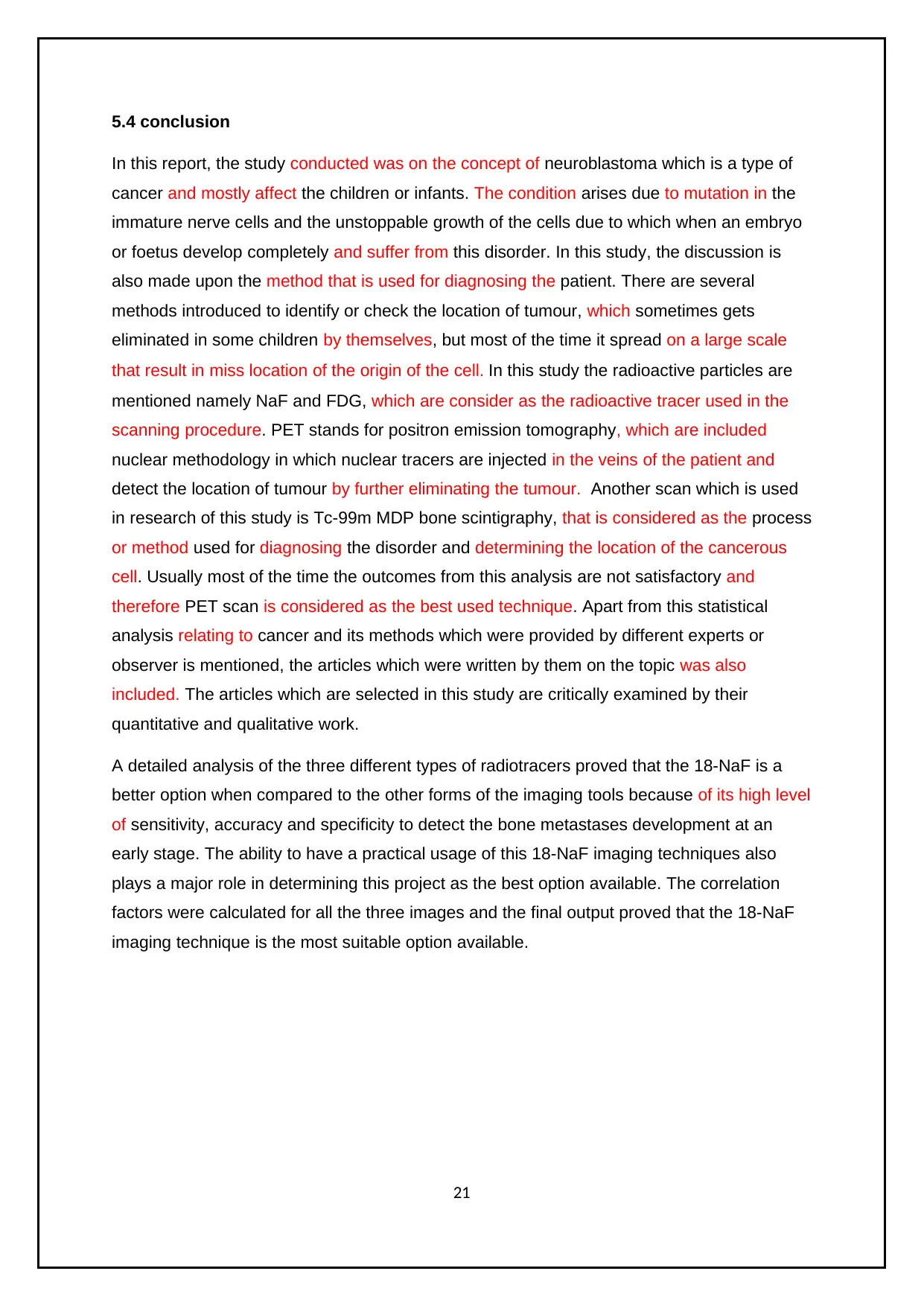
5.4 conclusion
In this report, the study conducted was on the concept of neuroblastoma which is a type of
cancer and mostly affect the children or infants. The condition arises due to mutation in the
immature nerve cells and the unstoppable growth of the cells due to which when an embryo
or foetus develop completely and suffer from this disorder. In this study, the discussion is
also made upon the method that is used for diagnosing the patient. There are several
methods introduced to identify or check the location of tumour, which sometimes gets
eliminated in some children by themselves, but most of the time it spread on a large scale
that result in miss location of the origin of the cell. In this study the radioactive particles are
mentioned namely NaF and FDG, which are consider as the radioactive tracer used in the
scanning procedure. PET stands for positron emission tomography, which are included
nuclear methodology in which nuclear tracers are injected in the veins of the patient and
detect the location of tumour by further eliminating the tumour. Another scan which is used
in research of this study is Tc-99m MDP bone scintigraphy, that is considered as the process
or method used for diagnosing the disorder and determining the location of the cancerous
cell. Usually most of the time the outcomes from this analysis are not satisfactory and
therefore PET scan is considered as the best used technique. Apart from this statistical
analysis relating to cancer and its methods which were provided by different experts or
observer is mentioned, the articles which were written by them on the topic was also
included. The articles which are selected in this study are critically examined by their
quantitative and qualitative work.
A detailed analysis of the three different types of radiotracers proved that the 18-NaF is a
better option when compared to the other forms of the imaging tools because of its high level
of sensitivity, accuracy and specificity to detect the bone metastases development at an
early stage. The ability to have a practical usage of this 18-NaF imaging techniques also
plays a major role in determining this project as the best option available. The correlation
factors were calculated for all the three images and the final output proved that the 18-NaF
imaging technique is the most suitable option available.
21
In this report, the study conducted was on the concept of neuroblastoma which is a type of
cancer and mostly affect the children or infants. The condition arises due to mutation in the
immature nerve cells and the unstoppable growth of the cells due to which when an embryo
or foetus develop completely and suffer from this disorder. In this study, the discussion is
also made upon the method that is used for diagnosing the patient. There are several
methods introduced to identify or check the location of tumour, which sometimes gets
eliminated in some children by themselves, but most of the time it spread on a large scale
that result in miss location of the origin of the cell. In this study the radioactive particles are
mentioned namely NaF and FDG, which are consider as the radioactive tracer used in the
scanning procedure. PET stands for positron emission tomography, which are included
nuclear methodology in which nuclear tracers are injected in the veins of the patient and
detect the location of tumour by further eliminating the tumour. Another scan which is used
in research of this study is Tc-99m MDP bone scintigraphy, that is considered as the process
or method used for diagnosing the disorder and determining the location of the cancerous
cell. Usually most of the time the outcomes from this analysis are not satisfactory and
therefore PET scan is considered as the best used technique. Apart from this statistical
analysis relating to cancer and its methods which were provided by different experts or
observer is mentioned, the articles which were written by them on the topic was also
included. The articles which are selected in this study are critically examined by their
quantitative and qualitative work.
A detailed analysis of the three different types of radiotracers proved that the 18-NaF is a
better option when compared to the other forms of the imaging tools because of its high level
of sensitivity, accuracy and specificity to detect the bone metastases development at an
early stage. The ability to have a practical usage of this 18-NaF imaging techniques also
plays a major role in determining this project as the best option available. The correlation
factors were calculated for all the three images and the final output proved that the 18-NaF
imaging technique is the most suitable option available.
21
Secure Best Marks with AI Grader
Need help grading? Try our AI Grader for instant feedback on your assignments.
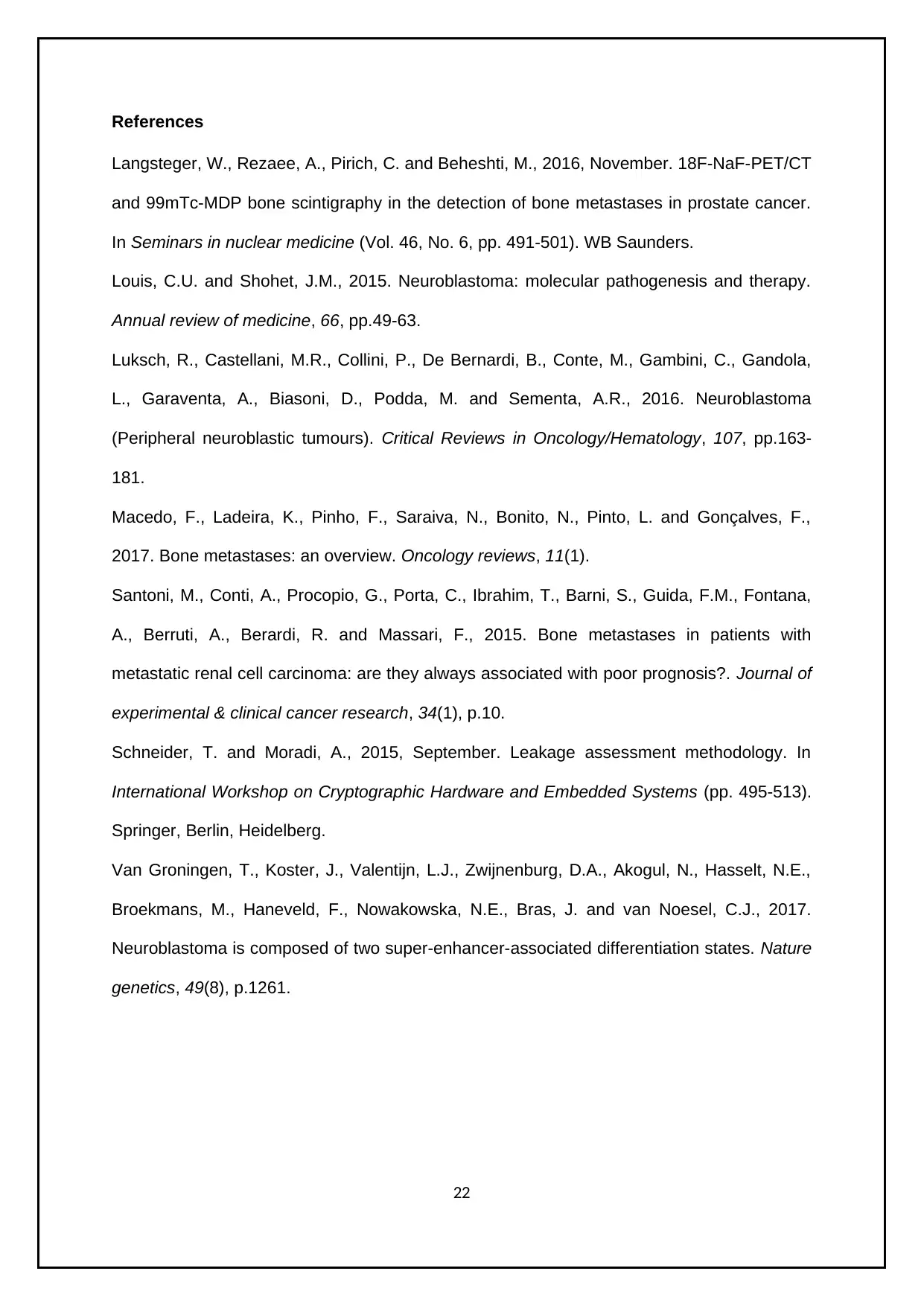
References
Langsteger, W., Rezaee, A., Pirich, C. and Beheshti, M., 2016, November. 18F-NaF-PET/CT
and 99mTc-MDP bone scintigraphy in the detection of bone metastases in prostate cancer.
In Seminars in nuclear medicine (Vol. 46, No. 6, pp. 491-501). WB Saunders.
Louis, C.U. and Shohet, J.M., 2015. Neuroblastoma: molecular pathogenesis and therapy.
Annual review of medicine, 66, pp.49-63.
Luksch, R., Castellani, M.R., Collini, P., De Bernardi, B., Conte, M., Gambini, C., Gandola,
L., Garaventa, A., Biasoni, D., Podda, M. and Sementa, A.R., 2016. Neuroblastoma
(Peripheral neuroblastic tumours). Critical Reviews in Oncology/Hematology, 107, pp.163-
181.
Macedo, F., Ladeira, K., Pinho, F., Saraiva, N., Bonito, N., Pinto, L. and Gonçalves, F.,
2017. Bone metastases: an overview. Oncology reviews, 11(1).
Santoni, M., Conti, A., Procopio, G., Porta, C., Ibrahim, T., Barni, S., Guida, F.M., Fontana,
A., Berruti, A., Berardi, R. and Massari, F., 2015. Bone metastases in patients with
metastatic renal cell carcinoma: are they always associated with poor prognosis?. Journal of
experimental & clinical cancer research, 34(1), p.10.
Schneider, T. and Moradi, A., 2015, September. Leakage assessment methodology. In
International Workshop on Cryptographic Hardware and Embedded Systems (pp. 495-513).
Springer, Berlin, Heidelberg.
Van Groningen, T., Koster, J., Valentijn, L.J., Zwijnenburg, D.A., Akogul, N., Hasselt, N.E.,
Broekmans, M., Haneveld, F., Nowakowska, N.E., Bras, J. and van Noesel, C.J., 2017.
Neuroblastoma is composed of two super-enhancer-associated differentiation states. Nature
genetics, 49(8), p.1261.
22
Langsteger, W., Rezaee, A., Pirich, C. and Beheshti, M., 2016, November. 18F-NaF-PET/CT
and 99mTc-MDP bone scintigraphy in the detection of bone metastases in prostate cancer.
In Seminars in nuclear medicine (Vol. 46, No. 6, pp. 491-501). WB Saunders.
Louis, C.U. and Shohet, J.M., 2015. Neuroblastoma: molecular pathogenesis and therapy.
Annual review of medicine, 66, pp.49-63.
Luksch, R., Castellani, M.R., Collini, P., De Bernardi, B., Conte, M., Gambini, C., Gandola,
L., Garaventa, A., Biasoni, D., Podda, M. and Sementa, A.R., 2016. Neuroblastoma
(Peripheral neuroblastic tumours). Critical Reviews in Oncology/Hematology, 107, pp.163-
181.
Macedo, F., Ladeira, K., Pinho, F., Saraiva, N., Bonito, N., Pinto, L. and Gonçalves, F.,
2017. Bone metastases: an overview. Oncology reviews, 11(1).
Santoni, M., Conti, A., Procopio, G., Porta, C., Ibrahim, T., Barni, S., Guida, F.M., Fontana,
A., Berruti, A., Berardi, R. and Massari, F., 2015. Bone metastases in patients with
metastatic renal cell carcinoma: are they always associated with poor prognosis?. Journal of
experimental & clinical cancer research, 34(1), p.10.
Schneider, T. and Moradi, A., 2015, September. Leakage assessment methodology. In
International Workshop on Cryptographic Hardware and Embedded Systems (pp. 495-513).
Springer, Berlin, Heidelberg.
Van Groningen, T., Koster, J., Valentijn, L.J., Zwijnenburg, D.A., Akogul, N., Hasselt, N.E.,
Broekmans, M., Haneveld, F., Nowakowska, N.E., Bras, J. and van Noesel, C.J., 2017.
Neuroblastoma is composed of two super-enhancer-associated differentiation states. Nature
genetics, 49(8), p.1261.
22
1 out of 23
Related Documents
Your All-in-One AI-Powered Toolkit for Academic Success.
+13062052269
info@desklib.com
Available 24*7 on WhatsApp / Email
![[object Object]](/_next/static/media/star-bottom.7253800d.svg)
Unlock your academic potential
© 2024 | Zucol Services PVT LTD | All rights reserved.





